1965-66 President's Report

The Board Of Visitors
Harry C. Wyatt, rector
Erwin H. Will, vice rector
George M. Cochran
Clifford A. Cutchins III
William J. Erwin
Mrs. Mavis M. Gibbs
John W. Hancock
Adger S. Johnson
E. H. Lane
William T. Rice
Mrs. English Showalter
Mrs. Jane G. Wilhelm
Wyatt A. Williams
Charles W. Wampler, Jr., ex officio
Dr. Woodrow W. Wilkerson, ex officio
Bulletin of the Virginia Polytechnic Institute. Vol. 59-No.8. August 1966. Published monthly by the Virginia Polytechnic Institute. Second-class postage paid at the Post Office at Blacksburg. Virginia 24060.

In Appreciation
The year now ended brought several changes in the membership of the Board of Visitors of Virginia Polytechnic Institute. E. H. Lane of Altavista and Erwin H. Will of Richmond both left the Board as the year ended, at the expiration of their terms. Earlier in the year the university was saddened by the death of William E. Blewett of Newport News. Also the ex-officio membership of Dr. Woodrow W. Wilkerson, state superintendent of public instruction, was eliminated by changes in the statutes governing Board membership enacted by the 1966 General Assembly.
The university is much indebted to all of these men and is appreciative of the long and distinguished service of those who have now left the Board. Their untiring efforts on behalf of Virginia Polytechnic Institute long will be remembered.
Governor Mills E. Godwin Jr. appointed three outstanding Virginians to the three vacancies on the Board: Clifford A. Cutchins III of Norfolk, John W. Landis of Lynchburg, and Waldo G. Miles of Bristol. The university also is indebted to those newly appointed to the Board. The sense of public responsibility which prompted them to agree to add new commitments to their already heavy personal and public schedules is indeed appreciated.
They have joined 11 other outstanding men and women in the sometimes burdensome and difficult task of guiding the operation and development of Virginia Polytechnic Institute in a critical and challenging period. This review of the past year's activities at V.P.I. is an appropriate place in which to acknowledge the university's sincere appreciation for the service of all its Board members.
An Assessment
Each new year on the campus of a growing university generates its own particular significance, for it provides a new measure of the institution's development. Its achievements and disappointments are more than statistical facts to be recorded in dusty archives and forgotten. Each year new students arrive, and others depart. Each year students and faculty alike are much immersed in the learning process. The record of the year is etched deeply into their individual and collective experience.
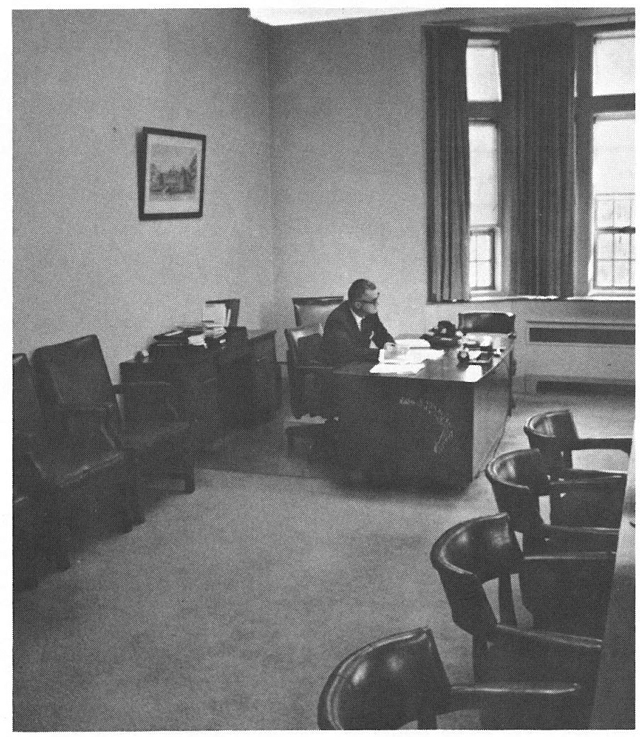
With each new year there is renewed opportunity to improve and refocus old programs, to find better answers to old questions, and to devise solutions to new problems. The vitality and strength of the university must be measured in large part by the energy and ability devoted to these tasks. This is all the more true in a context of rapid growth, when new resources can be made available to meet the demands of increasing enrollments and improved quality, and when substantial numbers of new faculty and staff can be recruited to join the outstanding men and women already in the university's service.
For in such a situation there occurs a cross fertilization of ideas and continued intellectual ferment. The creative excitement in the educational community that is the university becomes part of the atmosphere, an almost tangible thing. Such an atmosphere seemed very apparent at Virginia' Polytechnic Institute in the year now ended.
It was apparent earlier, but in 1965- 66 the new focus of the university began to emerge; many of the uncertainties and apprehensions of earlier years were dissipated, and plans began to be realities. Building on the achievements and planning of prior years and previous administrations, the mission of V.P.I. began to emerge in new clarity.
The university's basic mission emerges from Virginia's educational needs, and must relate the development of V.P.I. to the changing conditions and objectives of the Commonwealth itself. That mission, clearly defined by the Board of Visitors, is "to provide the best possible resident instruction for the qualified youth of Virginia," along with "strong research and extension programs to serve the needs of the Commonwealth."
Such a mission necessarily must involve the physical growth necessary to accommodate a larger proportion of the qualified students seeking admission, as well as the academic growth necessary to insure that the educational experience at V.P.I. will remain appropriate for its purpose.
This intensifies the requirement that the university's research programs be strengthened, both for the benefit of the instructional program and for Virginia's development. A properly structured extension program must be strengthened to disseminate new data and techniques from the laboratories throughout the state and the nation. The designation of V.P.I. as the administering institution for the new state-federal technical services program in Virginia last fall lends a new urgency to both the research and extension activities. The new program is designed to provide technical assistance to business and industry throughout the state.
The university is very much a part of Virginia and necessarily must be quite sensitive to changes in the state. The Commonwealth is very much in transition; it is changing very rapidly, from a state with primarily a rural orientation to a very urban state and from a very mixed economy to one that is basically industrial. An increasing majority of Virginia's citizens are concentrating rapidly in its urban areas, and much of the state is sustaining a very rapid population growth.
The Commonwealth's changing economy and new patterns of economic growth in the decades since World War II constitute a familiar story. The social, political, and economic implications of these changes are increasingly evident. The point here is that the trends developing in Virginia are cumulative, and in the year now ended Virginia's transition came into much sharper focus.
The record of the 1966 General Assembly, written into law, is reasonably conclusive evidence. The broadening of the Commonwealth's tax base and the new tax resources made available for all areas of Virginia's development, portends even greater changes in the years ahead. Virginia has begun to move into the main currents of our national life and is beginning to compete realistically with her sister states for a rightful share in the rising national economy and a more active role in national affairs.
Particularly heartening was the emphasis given to Virginia's educational programs -- to education at all levels -- in the 1966 Appropriations Act and in other legislation enacted last winter. The creation of a statewide system of community colleges, the strengthening of many public education programs, and the additional resources made available to the state-aided institutions of higher learning all have important implications for Virginia's future.
There were abundant signs that in education, as in the new patterns of economic growth, Virginia is no longer content to measure its progress with the South but seeks its guidelines from the development of the nation as a whole.
Thus, the rising level of support from the General Assembly for educational programs throughout Virginia was a key factor in the year's developments at V.P.I. More than 10 million dollars were appropriated to the university for new buildings and related capital outlays. The campus construction program, financed by revenue bonds, gifts, and state appropriations, exceeded 25 million dollars before the year was completed.
The General Assembly's general fund appropriations for V.P.I.'s instructional programs for the biennium now beginning totaled nearly 14 million dollars, an increase of more than 50 per cent over 1964-66. Maintenance and operation funds for Cooperative Extension were increased some 20 per cent. State support for agricultural research did not advance as rapidly as was perhaps necessary; the increase was about 6.5 per cent. Appropriations for the research in other areas, however, were more appropriately increased; the university research program now totals about 6.5 million dollars annually.
The quickened pace of the university's development was apparent in other areas, too. Gifts from alumni and friends far exceeded previous levels; alumni giving alone topped a million dollars. Illustrative of the rising level of support was a $100,000 Rockefeller grant for scholarships.
The university's academic progress in the year was notable. A series of new departments were structured, and a number of new major programs were added. Faculty salaries were significantly increased, and recruitment of new faculty continued with outstanding success. Also as the year ended, plans for consolidation of the university's extension and research programs were taking shape. These activities will be structured into university-wide Research and Extension Divisions.
These are among the reasons for the excitement and ferment now apparent within the university. It was a year of achievement; it did provide a new measure of the university's development. And as such a year must, it outlined all the more vividly the challenge of the years ahead.
T. Marshall Hahn, Jr. President
The Year In Perspective
The growth of Virginia Polytechnic Institute in the year now ended cannot be measured simply by increased enrollments, additions to the faculty and staff, or in the square footage and dollar volume of the construction program. The university is developing in a more significant sense; the academic and intellectual community which is V.P.I. is growing, and the perspective in which the institution functions is broadening. It is in this context, as much as in physical growth, that V.P.I. continues its transition.
The academic and physical growth of the university results from the larger demands made upon it by the increasing need for the expansion of higher educational opportunities in Virginia. It stems from both the state's rapid population growth and the changing social and economic conditions in the Commonwealth. Many factors influence the university's academic growth, and many of them are related closely to the physical expansion of the institution. Others relate to the ever widening horizons of the academic disciplines: to the sheer volume of information that man is accumulating about the physical world and the universe in which he lives and about the social system in which he must function.
The university's development has achieved a momentum which ultimately will carry it into the front rank of American institutions of higher learning. The events of the past year clearly have demonstrated the ability of VV.P.I.to achieve such a goal. They also have demonstrated the necessity and ability of the Commonwealth to provide unexcelled educational opportunities for its young men and women.
This recognition has been recorded in public policy, both by the leadership of the Governor's office and the General Assembly. The forthcoming statewide conference on education, recently called by Governor Godwin, will involve itself with planning for Virginia's overall educational development in the years immediately ahead. The additional public resources made available for the biennium now beginning will permit continued progress for V.P.I. and for other state-aided institutions. But more important is the basic change apparent in the Commonwealth's educational policies. Virginia, finally, has recognized the necessity of providing appropriate educational opportunity for its young people in the quality and quantity essential for its own development. Certainly the resurgent emphasis on the Commonwealth's educational needs is part of the creative excitement on the V.P.I. campus.

Ferment And Enthusiasm
Students and faculty alike were heavily involved in the ferment and enthusiasm of the growing university. The progress achieved in revision and improvement of many of the academic programs, in strengthening the faculty, in consolidating and extending the student life programs, and in broadening the depth and scope of the university's instructional, research and extension programs is very much a part of the record of the past year.
Countless hours have gone into analysis and evaluation of almost every aspect of the university's activities. Much of it involved a review of current course offerings and consideration of new approaches, new courses, and new programs. Although sometimes confusing to the student, the changes speak well for the efforts of the faculty to upgrade the academic program. It is a never-ending process, for change fosters re-evaluation, and re-evaluation sparks additional change. The process is the essence of quality education.
Several new programs have resulted from this continued effort. Most evident was the progress toward a better academic balance through the development and strengthening of the programs in the liberal arts and humanities. Noteworthy were the new undergraduate degree programs in philosophy, foreign languages, and in health and physical education, along with new Master's degree programs in English and history. A new Department of Psychology and Sociology also was organized.
The Departments of Foreign Languages and Political Science will function as separate departments in the year now beginning. A significant change in the core requirements in Arts and Sciences will assure greater breadth, but will emphasize more study in depth in the various areas. The changes should result in greater coherence and meaning for the students.
There are many other achievements also to be noted. The College of Business completed several years of faculty development with national accreditation. The Forestry Department similarly received professional accreditation. The College of Architecture devised a new approach to architectural education that has attracted national attention. The business education and home economics education programs were substantially revised to provide better teacher preparation in these areas. The honors program, initiated by a group of interested faculty, met with enthusiastic success.
The Faculty
Approximately 20 per cent of the teaching faculty was new as the school year began. A large proportion of the group represented new positions required by rising enrollments. The student-teacher ratio was maintained at reasonable levels, to provide for the necessary student-faculty contact essential for high quality education.
Substantial improvement of faculty salaries has had a marked effect on the strengthening of the faculty. Faculty salary levels for several years have been related to national averages for similar institutions and permit reasonable salary adjustments each year. The higher salaries possible under this' program have permitted retention and recruitment of many outstanding university teachers. Their dedication and abilities are demonstrated with increasing effectiveness in classrooms and laboratories.
The new faculty represent an unusually strong group. Their backgrounds range the whole of the United States and some foreign countries. When combined with the strong faculty already in the university's service, the new voices, new ideas and new approaches provide a valuable stimulation for the entire institution.
There is growing emphasis on research and graduate work, an emphasis counterbalanced by an increasing demand for quality instruction at all levels. The intermixture of teaching and research responsibilities is measurably strengthening both components of university work.
The Self-Study
It is particularly appropriate that the year-long self-study required each 10 years by V.P.I.'s accrediting agency, the Southern Regional Association of Colleges and Schools, has been in progress for most of the year. The self-study reaches into every corner of the institution, with each faculty member participating as he desires. It involves a review by each department in the light of 11 standards, each concerning a major component of the university's operations. The departmental reports are brought together by the colleges and reassessed before a review by university committees also considering each standard. The visible result will be a lengthy document; it will serve as the starting point for study by the accrediting team which will visit V.P.I. in the fall.
Perhaps the more significant result will be a greater understanding of the university the study and the report will generate. The self-study will originate many suggestions for improving various programs and activities in the university. Although a great deal of faculty and administrative time was devoted to the study, the benefits will more than compensate for it. The detailed study will leave the university in a much stronger position to continue its growth, and its quest for excellence and stature.
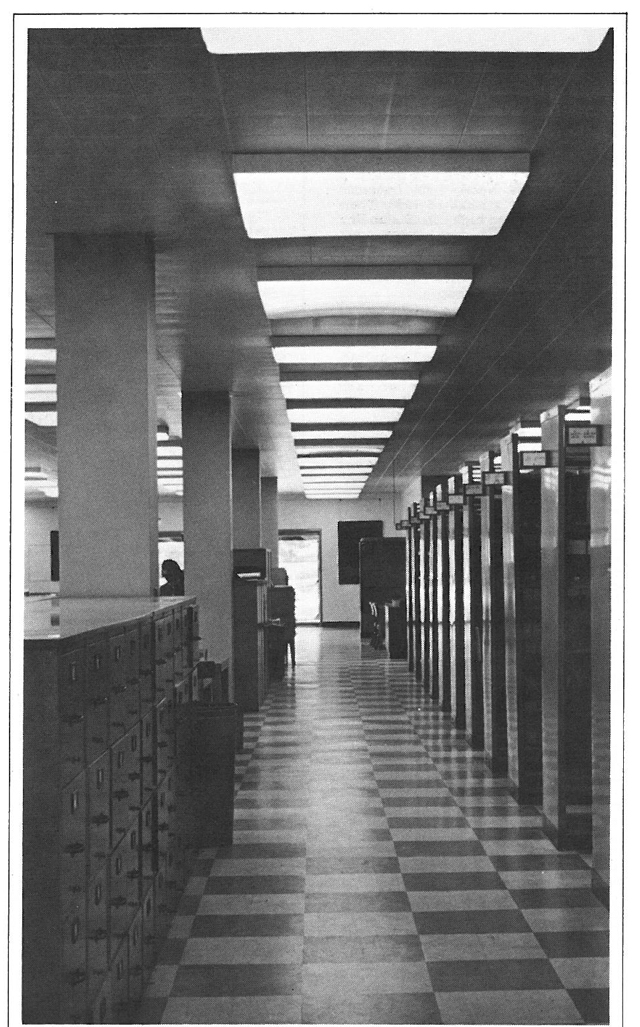
The Library
The strengthening of library resources also should be noted; it is a top priority program for the growing university. Book purchases in the year now ended exceeded those of any previous year; library holdings now total nearly 400,000 volumes. Appropriations for the new biennium now permit book purchases at the rate of some $250,000 annually. Library deficiencies are being rapidly reduced, although substantial additional resources are needed.
In January the library began automating its library procedures, beginning in the acquisitions department. Machine methods will be extended in other areas. The increased library load has created space problems for the library staff, although shelf space is still more than adequate. The quick availability of the resources of other college and university libraries, effected by a statewide teletype system, has been quite beneficial.
The Students

No component of V.P.I. is more aware of the university's growth and transition than its students. Nearly 1,800 freshmen entered V.P.I. in the fall of 1965. Their caliber, in terms of high school standing and student aptitude test scores, was very high. By the measurable standards available, V.P.I.'s entering students compare favorably with most of the nationally outstanding universities.
The selectivity of new students, of course, was a major factor; only about one of every three applicants for admission could be accommodated. The university's rising academic standards were apparent, but clearly hundreds of well qualified applicants could not be admitted.
The construction program, which will provide dormitory space for some 1,400 additional students this fall, is somewhat easing the admissions pressure. Admissions for 1966-67, now closed, will increase the university enrollment to nearly 8,400. Total enrollment a year earlier exceeded 7,000.
The rapidly climbing enrollments necessitated a series of innovations in the university's student life programs. The student leadership responded with commendable zeal to the quickening pace of V.P.I.'s development, under the guidance of the Dean of Students and his staff. During the spring a new dormitory assignment plan was implemented to permit civilian sophomores, juniors and seniors to select their dormitory rooms and roommates for the following year, with a proportional number of each class in each building. House councils and an inter-dorm council also were established, to provide opportunity for more meaningful self-government and leadership activities. The system is designed to generate an academic and social rivalry between the various residence halls, as well as the self-government of each dormitory and of the inter-dormitory council.
Also during the year, the political structure of student government was reorganized, with the consolidation of the cadet and civilian student bodies and the election of an over-all student body president. The closer working relationship of civilian and cadet students in student government undoubtedly will benefit both groups.
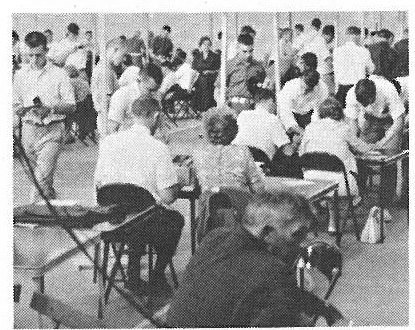
The Cadet Corps enrollment dropped somewhat during the year, and stabilized at about 1,300. The Corps' adjustment to its role as a military college within the larger university was apparent, however, and the Corps' leadership revised its military programs better to fit its own requirements into the university's over-all development. Additional study by a student-faculty-administrative committee is now under way to devise further efforts to strengthen the Corps. And with the larger enrollment in the fall, the number of students who elect to enter the Corps will increase somewhat.
The university's growing co-educational enrollment -- about 350 girls were on campus this past year -- saw the appointment of V.P.I.'s first full-time dean of women, and the development of new student life programs for the women students. The renovation and conversion of Eggleston Hall, a men's dormitory, for women students will permit their enrollment to double in the fall. Additional staff women are being provided for dormitory guidance and counseling.
The completion of a third high-rise dormitory, to house more than 1,000 students, is scheduled this winter. This will permit renovation and conversion of another men's dormitory for women students; it will be available for co-ed housing by September, 1967.
The composition of the V.P.I. student body also is changing in other respects. More than 1,000 married students enrolled in the fall, and with the trend toward early marriage, the total climbed somewhat during the year. Married students constitute an increasing proportion of the university's enrollment.
The university's admission's policy limits enrollment of out-of-state students to approximately 20 per cent of the total undergraduate group. Students from 44 of the 50 states were enrolled, and some 44 foreign countries were represented on the campus. Students from every county and city in Virginia also were enrolled. The diverse enrollment is essential for educational purposes, although the university's primary responsibility is to the state it serves.
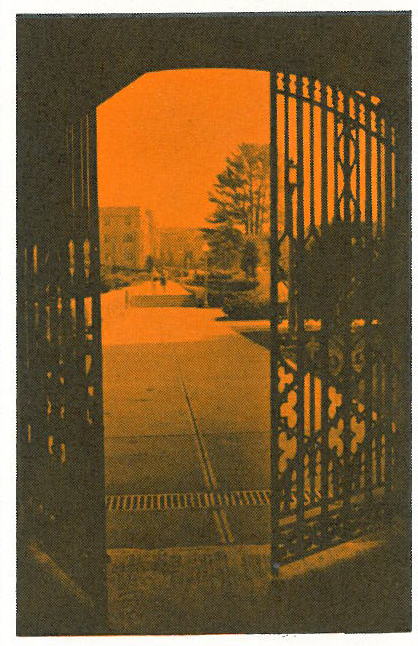
Dormitory construction programs are designed to continue housing approximately 70 per cent of the university's enrollment. The university continues to encourage private investors to provide additional housing for the growing numbers of married students and those in graduate work.
The strengthening of student services has been noteworthy in many programs during the year. The resident advisor program, which provides resident advisors in each dormitory, was enlarged. In addition to on-campus programs, university supervision of off-campus housing for safety and suitability was increased, and a placement service for students seeking part-time employment was made available. The Placement Office also strengthened its placement programs for graduating seniors and other students 'leaving the university. The student counseling service has been increasingly effective. The religious affairs office provided additional strength in the student programs and was particularly effective in its work with married students and foreign students. The summer orientation program for students and their parents and the fall leadership training program for student leaders made increasingly significant contributions to the effectiveness of the student life programs.
Student Center
Particularly important was the funding and development of final plans for the new Squires Student Center, to be constructed by the expansion and renovation of the existing student activities building. Student leaders and university officials worked in close cooperation in the planning of the larger facility. Construction, financed partly by revenue bonds and by state appropriations, will begin in the fall, and will be completed in the fall of 1968.
The area of student activities is of major importance to the university, located as it is outside a major metropolitan area where many community cultural, educational and recreational facilities are available. Yet V.P.I. has a unique opportunity to provide an ideal environment for its students, reasonably remote from urban distractions but close enough to provide the necessary business, cultural, and educational contact with the cities.
The expanded student center will be of greater benefit in providing on-campus opportunity for leisure time activity. The larger number of women students and the lounges available in the girls' dormitories for social activities also will be helpful. The university's efforts to enrich its student programs are progressing, but much remains to be done.
There are, of course, a variety of activities and organizations which contribute to social and cultural opportunities for the students. The Visiting Scholars Program annually brings outstanding scholars to the campus for convocations, seminars and other events. The community concert programs, the YMCA Conflict program, the annual Tech Festival, the dance clubs, the social, regional and special interest clubs, as well as the academic clubs, all are helpful. Also the expanding physical education and intramural sports programs offer major contributions. The university's efforts to provide an environment most conducive to the social and educational development of its students are continuing. They will be intensified in the year ahead.
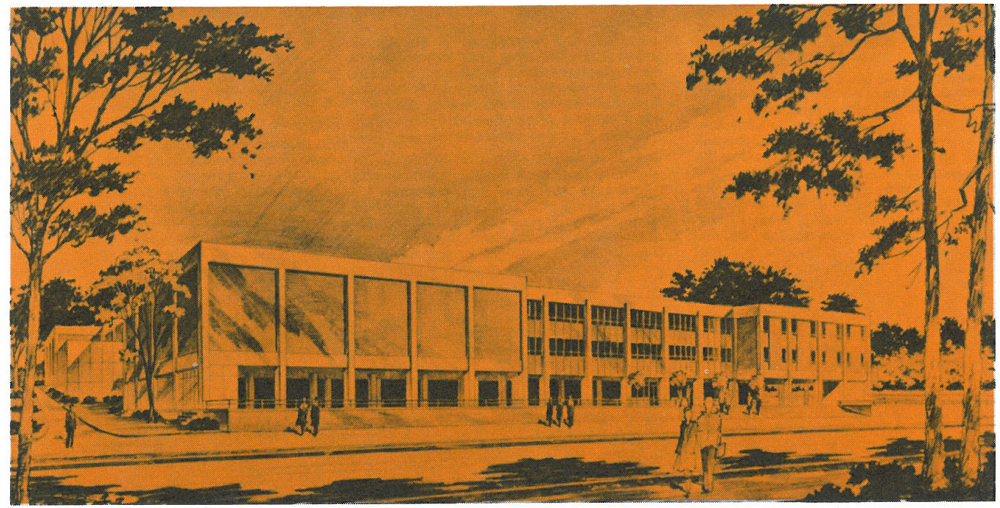
Physical Plant
The growth of the university, necessarily, produces logistical problems, The new construction now beginning requires the razing of many temporary and outmoded buildings, and the deterioration of McBryde Hall also necessitated its demolition. The university in the fall acquired the abandoned public school property adjacent to the campus, and the three buildings there are now being renovated for temporary use.
Without the excellent cooperation of the faculty and students, the problems of temporary housing for many activities and departments would be insurmountable. In academic areas, where a high rate of space utilization is already evident, available classrooms, laboratories, and offices are being used even more intensively. Some of the buildings are crowded much more than is desirable. Many student activities as well as instructional programs will be housed in temporary quarters for the year now beginning. The student activities building also will be closed in the early fall.
It is evident, also, that when the new buildings now being constructed are completed, the university's rapid growth will require still more construction. The growing pains will be evident for some time to come. But the need more than validates the difficulties. The emerging national distinction of the university and the larger contributions to the state and nation of which it is capable require all possible effort.
A review of the past year at V.P.I. is a stimulating exercise; the achievements and disappointments, the problems and opportunities, the blending of past and future into the actions and plans, all comprise a record of some substance and significance. Other sections of this report will detail many of the year's accomplishments and plans for future development. In many respects it was a satisfying year, for rooted in the year now ended will be many future achievements.
The Colleges
Agriculture
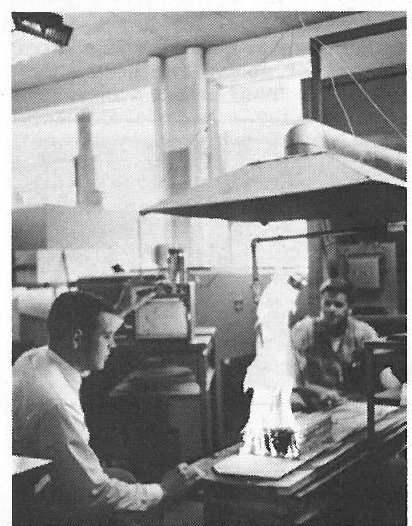
Career opportunities for graduates from the College of Agriculture are increasing much more rapidly than enrollments. Prospective employers sought more than three times the number of agriculture graduates available in June, and one company offered summer employment to as many as 500 students to acquaint them with the opportunities available.
Beginning salaries for bachelor's degree graduates ranged from $5,600 to more than $8,500; the average was up some $400 from the previous year. A series of surveys indicate the demand for graduates will continue to increase even more rapidly during the coming decade.
Total enrollment in the fall of 1965 was about 755, up about 100 from the previous year. This included approximately 200 Master's and Ph.D. degree candidates. Admissions applications from graduate students from major universities throughout the nation are increasing rapidly. And despite the availability of fewer graduate assistantships for the coming year, admission acceptances also are increasing substantially. The trend is indicative of the national prominence of the College and provides an index of the national caliber of the faculty and its reputation as viewed by colleagues in other major universities.
The largest curriculum enrollment was in Forestry and Wildlife, which was fully accredited during the year by the Society of American Foresters. The department's increasing enrollment and the intensive demand for forestry graduates are severely taxing its facilities. It almost certainly will be necessary to limit admissions to forestry programs in the fall of 1967 until additional facilities become available.
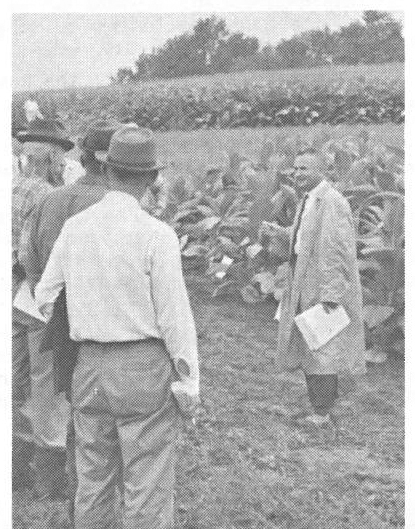
The College's basic mission is to serve effectively the Commonwealth's industry of agriculture, but the broader responsibility of assisting the people of the underdeveloped nations of the world can not be ignored. To assist the food supply efforts in many countries, a proposal was submitted during the year to the Agency for International Development for the development of a program to prepare students for careers in international agriculture. Courses in this field can be offered in the College's current operations, but additional financial support will be required to provide participating experiences in South American countries.
Meanwhile, there has been continued an intensive review of all of the College's programs of instruction, aimed at redesigning them to provide more effectively the necessary educational leadership for the industry of agriculture. Perhaps the key to survival in an era of accelerating technological developments in agriculture is to keep pace with the changes which are increasingly apparent. But the key to leadership clearly is the College's role in initiating necessary changes to meet new conditions.
For example, the Departments of Dairy Science and Plant Pathology and Physiology have been conducting an intensive staff study of their instructional programs during the past two years. Extensive revisions have been developed to strengthen both programs. Each course offered on the undergraduate and graduate level has been restructured to provide the necessary professional background for students in their respective fields. To implement the course revisions, however, it was necessary to modernize the laboratories and provide the equipment necessary for instruction appropriate to professional leadership in these fields. The strengthening of these programs will permit them to compete favorably with those of the major universities in the nation.
In scholarship support, eight additional scholarships were established during the year: two $2,000 scholarships will be awarded at the rate of $500 per year for four years; four $500 scholarships will be awarded to freshmen and transfer students in dairy science; one $500 scholarship will be awarded annually to a forestry student, and a $300 scholarship will be awarded each year to a qualified agriculture student on the basis of need. Final arrangements have not yet been completed for several other proposed scholarships. A critical need remains, however, for additional financial support for students, particularly for sophomores and upperclassmen in need of assistance.

More than 100 entering students and their parents are scheduled to attend the College's summer orientation program in July. The program last year proved quite successful, and it is being continued. Also under way during the summer is the science program for high ability secondary school students. An outstanding group of high school juniors are spending eight weeks on the campus in study and research centered around the theme "Enzymes, the Key to Life."
Other student programs, particularly research participation work for undergraduates and the counseling program, are being strengthened substantially. The program of research opportunity for students currently is being evaluated for necessary changes aimed at more efficient use of faculty and better motivation of the students. It is designed to permit students to work with an outstanding scientist on research projects as junior researchers.
Among the scholars visiting the College or its departments during the year were Dr. David K. Detwiler, chairman of veterinary medical science at the University of Pennsylvania; Dr. O. Burr Ross, vice president for agricultural research, Oklahoma State University; Dr. Robert E. Taylor, director of the Center for Research and Leadership in Vocational and Technical Education, Ohio State University; Dr. Paul DeBach, professor of biological control, University of California, Riverside; and Dr. Frederick B. Hutt, emeritus professor of genetics, Cornell University.
Architecture
Our society increasingly is aware that man's surroundings in the 20th Century do not provide satisfactory conditions for living. The related disciplines of architecture, architectural engineering, building construction, urban design, and urban and regional planning, all are heavily involved in much needed efforts to provide a more appropriate environment for America's citizens. The faculty of the College of Architecture is well aware of the need for a new dimension in education for these disciplines.
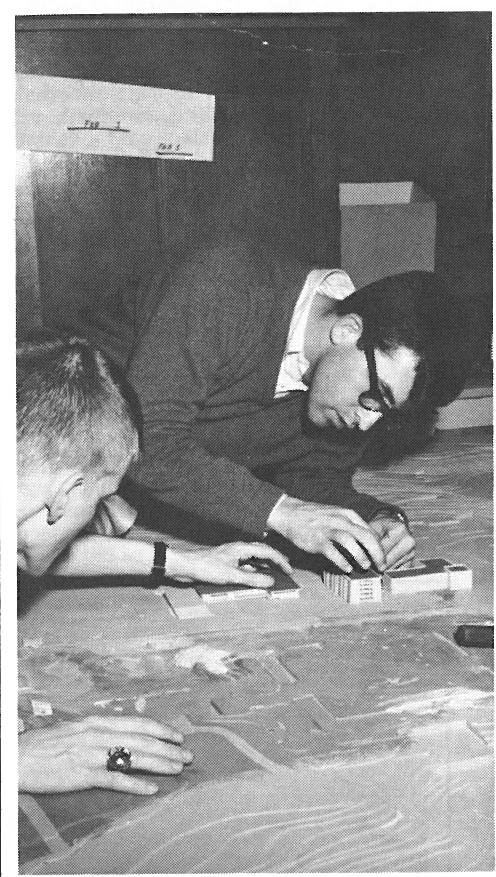
During the year now ended the faculty has completed a review of the architectural curriculum, aimed at developing a much broader concept of architectural education. A series of curricula changes are now under consideration for coming years. A grant of $2,500 from the American Institute of Architects' Educational Research Project will permit the preparation of a report on the curricula revisions so that the innovations planned here might be recorded for distribution throughout the nation.
The graduate programs in urban and regional planning and in urban design particularly will be expanded and strengthened. A number of new faculty additions will contribute substantially to the stronger program, both in instruction and leadership. The faculty of the undergraduate curriculum in architecture similarly is restructuring its program to provide more effective methods of teaching and to broaden and intensify its lecture curriculum. Prof. G. D. Ding of the University of Sydney will be in residence as a visiting professor during the year, and several other faculty additions will add strength to the program.
The College's enrollment continues to grow rapidly. In the fall of 1965, the second year since its organization as a separate college, nearly 400 students were enrolled. Little increase will be possible in September, however, because of limited facilities. A portion of the instructional program is being moved into temporary quarters for the coming year. The new architecture building, for which somewhat more than a million dollars has been appropriated, is expected to be available for use in the fall of 1967. Construction will get under way later this year. The new structure will provide not only for increased enrollments but also the space necessary for the more intensive instructional programs.

The College faculty members were active during the year as consultants to professional organizations and agencies both in Virginia and throughout the United States and several foreign counties. Numerous papers were contributed to a series of symposia and conferences. It also should be noted that the building construction faculty was active in the development of a new national Associated Schools of Construction. Prof. William L. Favrao Jr. was elected vice president of the new association, and Prof. Richard M. Larimer serves on its educational committee.
Distinguished lecturers were visitors at both the College in Blacksburg and the seminars of its Washington program in urban studies, the College's resident graduate study program in the nation's capital. Abraham Beer of France; Katherine Kuh, distinguished critic and author; Philip H. Lewis Jr. of the University of Wisconsin; Henry Millon of M.I.T.; and H. T. Cadbury-Brown of London were among them.
The exhibit series also was continued during the year, and included a retrospective exhibit of the work of the distinguished architect Walter Gropius as well as a showing of a collection of paintings of Walter Biggs, the celebrated Roanoke artist.
Student activities were highlighted with the Symposium on New Town Planning, sponsored by the Building Construction Student Association in recognition of its 10th year as a student group. The College's honors convocation in May bestowed 38 awards on its outstanding students, among them, again, two awards by the American Institute of Architects' and the American Council of Student Architects for summer work-study scholarships in England. The architectural students also sponsored and produced a new student publication, A5, (for the College of Architecture and its five disciplines) which appeared just prior to the close of the academic year.
The year ahead holds great promise as continued emphasis is placed on both the recruitment of faculty committed to excellence in teaching and research and as more effective ways are found to provide appropriate education for professional persons prepared to play an effective role in bringing order, form and vitality to man's surroundings.

Arts & Sciences
The broadening academic concerns of the university were evident in all of its colleges in the year now ended, and the College of Arts and Sciences was much involved in many of them. Arts and Sciences bears a heavy responsibility for the basic educational work of many of the students enrolled in the other colleges. More than half of the teaching responsibility of V.P.I. is now centered in Arts and Sciences.
Yet the College's own major programs also are developing rapidly; its fall enrollment exceeded 1,500, and the students admitted for the coming year will result in even more rapid growth. The Bachelor of Arts degree, reinstated by the university for the first time since 1886, was awarded to some 50 candidates in June, in recognition of the College's broadened arts curriculum.
Nearly 250 arts and sciences students were candidates for advanced degrees this past year. During the year, new Master of Arts programs were approved for English and history. New undergraduate majors were authorized in French, German, and Spanish; in health and physical education; and in philosophy. Three new departments were organized: Foreign Languages, Political Science, and Psychology/Sociology. A series of humanities courses in such fields as music, art, and theater was approved as a new general arts and sciences program to be offered for the first time this fall.
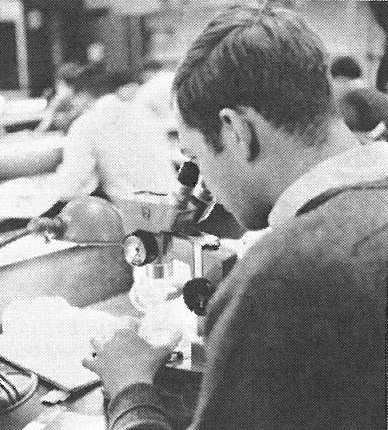
The year also saw the beginning of the Honors Program, which included honors sections in English, history, mathematics and chemistry, and interdisciplinary honors seminars. It has been expanded to include additional honors sections and sophomore-level students during 1966-67.
The College's core curriculum also was revised. Related courses have been organized into three major areas: the humanities, social sciences, and natural science and mathematics. Teacher preparation and ROTC programs supplement the major division offerings.
In this connection the total number of hours required for graduation was reduced from 198-199 to 189-190. Continuing upper division students, with the exception of seniors, will elect the old or new curriculum by January 3, 1967. All incoming freshmen will enroll under the new curriculum.
Approximately 50 additional faculty members will be teaching when the new school year begins in September. About 40 new faculty positions have been filled, several faculty members will return from academic leave, and several vacant positions have been filled. The faculty recruitment program has been quite successful.
These facts all are indicative of the university's efforts to strengthen its arts and sciences programs and better balance the educational opportunities at V.P.I. Arts and Sciences has been organized as a separate college only since 1962; it developed from the complex of general education courses originally organized for students in engineering and other professional fields.
Under the leadership first of Dean G. Burke Johnston, and last year Dean Leslie F. Malpass, the College has moved rapidly to provide a broader range of educational opportunity at V.P.I. Individual faculty members have initiated innovations in team teaching, varying the size of class sections, and utilizing new audio-visual methods and programmed instruction. Much more careful experimentation in new methods of effective teaching remains to be structured into the college programs, but an encouraging start has been made. The high quality of instruction in the College, and the enthusiastic innovations being made for its improvement, are very much a part of the creative excitement apparent at the university. It should be noted, perhaps, that the top 10 places in the selection of the university's most outstanding teacher of freshman students were won by members of the College faculty. The $500 award, created by Dr. and Mrs. Philip Sporn, was made for the first time this past year; it went to Dr. Luther K. Brice, acting head of the Chemistry Department.
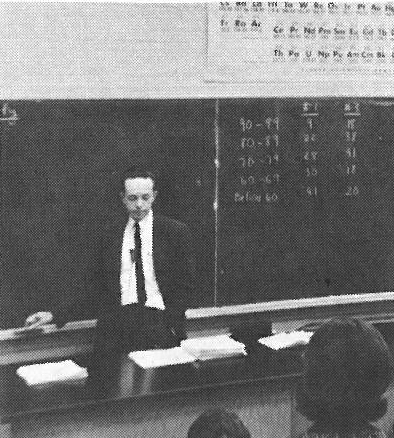
Similarly, the year's scholarly achievements included publication of 12 books by 10 faculty members, along with a long list of scholarly articles and technical monographs, reports, and reviews. Members of the Physics Department were active in research at the Virginia Associated Research Center at Langley, and many of the faculty served as consultants for a variety of public and private agencies.
The Visiting Scholar program brought a series of outstanding scholars to the College during the year. They included Dr. Dael Wolfle of the American Association for the Advancement of Science; Prof. Jacques Abram, the pianist, University of South Florida; Dr. Michael J. Pelczar Jr., professor of microbiology, University of Maryland; Dr. Fred Basolo, professor of chemistry, Northwestern University; Dr. Herbert A. Tonne, chairman, business education, New York University; Roberto Bravo Villarroel, curator of the Cervantine Library, Instituto Technologico de Monterrey, Monterrey, Mexico; Dr. Jeri Konta, University of Prague, Czechoslovakia (mineralogy and geochemistry) ; Prof. Harry T. Williams, Boyd professor of history, Louisiana State University; Dr. Hans Sagan, professor of mathematics, North Carolina State University; Dr. John S. Maybee, Purdue University (mathematics); Dr. John Hicks, dean, University College, Southern Methodist University; Dr. Arthur H. Rosenfeld, professor of physics, University of California, Berkeley; and Dr. Oscar Kempthorne, professor of sciences and humanity, Iowa State University.
Noteworthy was the growth of the university's teacher education program. Approximately 300 undergraduates were enrolled in liberal arts and life sciences teacher preparation programs, and about 250 were in various vocational education and industrial arts education programs.

The new health and physical education major also is primarily designed to provide physical education teachers for Virginia's school system. Some 250 new teachers are needed in the state's schools each year, and virtually all are recruited from other states. Aside from teacher training, the intramural athletic programs are an important part of the university's activities. This past year several thousand students were participating in intramural sports: football, golf, swimming, bowling, handball, volleyball, basketball, softball, and a variety of other sports.
Some of the intercollegiate programs also are developing from intramural sports. Gymnastics, for example, is developing as both an intramural and intercollegiate program. Soccer, a popular intramural sport, also will be developed into an intercollegiate program.
During the summer of 1966 the College took part in the summer orientation program for new students and their parents, and plans were being developed during the year for an international education program, aimed at exploring the possibility of course offerings in foreign universities, student exchange plans, and the exchange of faculty to broaden educational perspectives.
Business
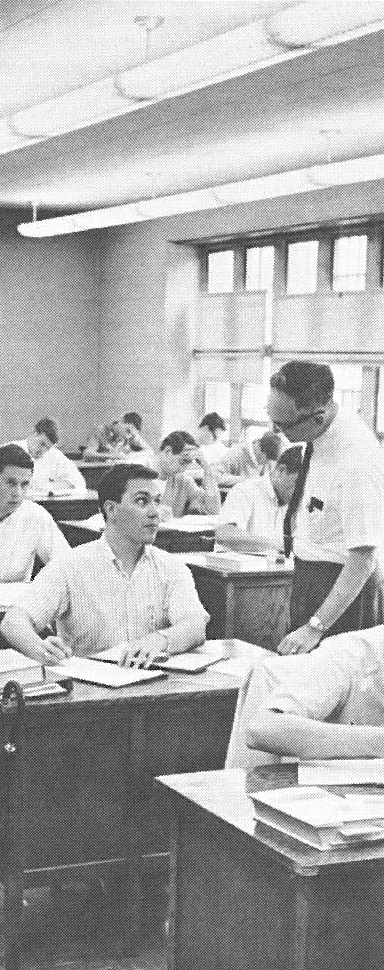
The continued strengthening of the standards and quality of the programs in the university's College of Business was given national recognition in the spring when it was accepted to membership in the American Association of Collegiate Schools of Business.
Long regionally accredited, the national accreditation of the College's undergraduate business education curricula is but another step in the continued broadening of its educational opportunities. The business curriculum was separated from the arts and sciences programs in 1961 and was organized as a college in 1964.
It has been structured in three departments: Accounting, Business Administration, and Economics. Majors are offered in all three areas, and students majoring in business administration may concentrate their work in finance, management, or marketing.
In addition, majors are offered in business education and public administration, in cooperation with the Department of Education and the Department of Political Science, respectively. A joint program provides a major in economics in the College of Arts and Sciences. Business courses also are provided for students in other colleges, and a pre-law program has been organized.
The College thus seeks to provide a basic professional education, combining a general education approach with broad programs in business. A continuing review of the College's curricula, aimed at better relating instruction to emerging business education needs, has resulted in several curricula revisions. A number of courses have been dropped, others added, and the emphasis of others changed to stress the qualitative approach and scientific decision making. As was noted a year ago, the trend of student interest is away from general business and public administration and toward accounting, economics, management, and marketing.
Fall enrollment climbed to 1,162, an increase of somewhat more than 7 per cent. Bachelor's degrees were awarded to 243 graduating seniors in June; 11 master's degree candidates also completed their degree requirements. Admissions for the coming school year indicate a substantial growth in 1966-67. Recruitment of additional faculty for the higher teaching load has been quite successful; more than a dozen new faculty have been employed, most of them with Ph.D. degrees or equivalent professional qualifications from nationally recognized universities. They include the head of the Department of Economics at George Washington University, who has been appointed to a similar post at V.P.I. Nine new faculty members were employed in the year now ended, all highly qualified for teaching and research responsibilities. Several faculty members completed their doctoral work this past year, and three others will do so in the summer.
A noteworthy increase in faculty research and publication efforts was apparent during the year; a series of articles were published in appropriate journals and other publications. Many faculty members presented papers for professional societies and at the annual meeting of the Southern Economics Association and the American Economics Association. Appropriate research efforts increasingly have occupied the attention of college faculty along with more effective use of the facilities of the Computer Center for computation and analysis.

Similarly, the faculty has been active in management programs. A management course for the National Aviation Trade Association was made available in the summer of 1965 with a large number of industry representatives participating. The course will be offered again in September in three sections; two involving the basic management course and the third an advanced course.
The Visiting Scholars program in the College included Prof. Kenneth E. Boulding, professor of economics at the University of Michigan; Dr. John H. Hollomon, assistant secretary of Commerce; Dr. Peter F. Drucker, internationally known management consultant, educator and author; and Charles B. Thornton, chairman of the board and chief executive of Litton Industries, Inc. The latter three were university-sponsored scholars who participated in a series of convocations and discussions with Business faculty and students.
Other noteworthy activities in the College during the year included the expansion of the Cooperative Education Program for business students, inaugurated in 1964-65. Both the number of students and the cooperating business and industrial firms were increased, as the program became better known. Planning for research and service activities continued. Particularly in the area of continuing education, the potential for public service is very great. With the faculty growth now occurring, and with the availability of the university's Continuing Education Center, the College's activities in these areas will be considerably expanded.
Engineering
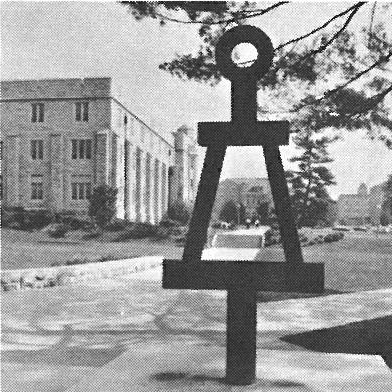
In an age powerfully influenced by the social and practical implications of engineering and science, the College of Engineering necessarily must devote more of its attention to the changing focus of engineering education In the past year th College faculty has been heavily involved in a series of studies concerning the present and future goals of engineering education. Among them were the American Society for Engineering Education study, the V.P.I. self-study, and the preparation of the report for the accreditation review of the Engineering Council for Professional Development. The College's continuing review of its engineering curricula is aimed at improvement of all of the College programs, and adapting them to the unending advances of science and the contemporary and future requirements of industry.
The reduction last year in the third and fourth year student requirements necessitates further refinements, the deletion of duplicate offerings, and more efficient subject matter presentation. The changes also require further evaluation of required courses. College committees currently are examining the requirements in chemistry, physics, and in the humanities. Proposals in the humanities are designed to provide more depth in a subject matter area than is possible in the current procedure permitting a beginning course in each of several areas. These studies and development of a three-quarter course which will introduce freshmen to the concepts of creative engineering design and rigorous, disciplined environment of an engineering career should result in substantially improved engineering programs.
Engineering enrollment in the fall increased to more than 3,100 students -- up about 3 per cent -- an increase about the same as that a year earlier. There was, however, a considerably lower attrition rate during the year's second and third quarters.
Bachelor of Science degrees were awarded to 461 candidates in June. In addition, 85 Master of Science degrees were awarded, along with 19 Ph.D . degrees; the growth of the graduate programs is continuing. The substantial increase in V.P.I. enrollment in the coming academic year also will mean a larger engineering enrollment; nearly half of the university enrollment continues to be in engineering.
Replacements and new faculty appointments will require 34 faculty positions to be filled for the coming year, and a large proportion of the new faculty members have been appointed. Approximately 80 per cent will have their terminal degrees. Ten faculty members were on educational leave this past year, three completed requirements for their Ph. D. degrees. Eight will begin or continue their work toward the doctorate in the coming year. The new faculty appointments include the head of the Department of Electrical Engineering.
The new student counseling program, involving a one-day orientation period and individual interviews with freshmen and their parents was conducted for five weeks during the summer of 1965. Approximately 75 per cent of the freshmen reported for the orientation program, and and reports indicate the students and parents were most favorably impressed. A three-week orientation program similar to that offered last year has been scheduled during July.
The summer program permits a better selection of students and a more realistic understanding of educational goals and the recognition of the effort required to achieve them. During the school year counseling services were made available to all freshmen and those with developing academic problems were directed to the counseling office for interviews. A full-time counseling service is available for such assistance.
Also in 1965-66 the Cooperative Education Program, under which V.P.I. students alternate quarters studying on the campus and working in industry, continued to grow. The program was expanded to include Master's level work in industrial engineering. Employer demand for participating students is now larger than the number of students available. H. Stuart Smith, director of the program, resigned in the summer of 1965 to begin work for his Ph. D. degree. Prof. Robert H. Pusey of chemical engineering and H. Norvel Camden Jr. of electrical engineering were named director and assistant director, respectively.

New and replacement equipment obtained during the year totaled more than $180,000, almost half of which was donated by industrial friends of the university. The largest gift, a shaker installation with complete control equipment, was provided by the Western Electric Co. It is a valuable addition to the Mechanical Engineering laboratory.
The College faculty was active in a variety of scholarly and professional activities during the year. Many were engaged as consultants in industry; others were employed in engineering assignments in industry during the summer of 1965. Many were active in various professional organizations, and several faculty members attended summer institutes in their professional fields. Others were authors and co-authors of several new textbooks in a variety of fields.
Dr. Fred R. DeJarnette, associate professor of aerospace engineering, was winner of the newly established $500 Sporn Award for teaching excellence within the engineering faculty.
Several distinguished scholars participated in lectures and seminars for the students and faculty. They included Dr. Philip Sporn, an eminent engineer and former president of American Electric Power Co.; Dr. William Gomberg, professor of industry, Wharton School of Finance and Commerce of the University of Pennsylvania; Dr. Maurice J. Zucrow, Atkins professor of engineering at Purdue University; and Dr. H. Beecher Charmbury of the Department of Mines and Mineral Industries of Pennsylvania. They were brought to the campus under the auspices of the Visiting Scholar Program.
Also during the year, the College's research activities made substantial progress. Sponsored research programs increased substantially over the previous year. And a number of intensive short courses and conferences were scheduled during the year, designed to keep engineers and teachers current in their fields. The annual summer space conference concerned "The Exploration of Venus and Mars."
Home Economics

The home and family continue as the pivotal influence in human development. In this age of rapid social change, where constant adaptation must take place, an ever-expanding body of knowledge concerned with better understanding of the family and its complex functions in our society is increasingly important.
For the family is a setting for individual growth and development, a social group, a consumer market unit, and an economic force. The continued cohesiveness and viability of the family and the success with which it fulfills its functions will depend in no small part on the quality of the educational and research programs with their central focus on the family, its concerns, and on the number of people reached by these programs.
Thus the College of Home Economics constantly is challenged to develop, to adapt, and to expand its programs in research and teaching, both on and off campus. Its academic programs are oriented to the family and the environmental factors which affect it. They provide a liberal education in the natural sciences, the social sciences, and the arts, with specialized study in subject-matter areas within home economics. The programs relate basic concepts of the arts and sciences to an understanding of the needs of people: food, clothing, housing, management of family resources, and human relationships.
Because of the broadening framework of knowledge and the increased professional demand for home economics graduates with a specialized area of concentration, the College's undergraduate major in general home economics was dropped during the past year. Also a teaching option was initiated so that the student may qualify for the teaching of home economics in Virginia secondary schools.
The major areas of specialization in the College are 1) clothing, textiles and related arts; 2) human nutrition and foods; and, 3) management, housing and family development. These areas are, of course, closely related, and they are considered different phases of the total home economics program.
The professional demand for home economics graduates far exceeds the supply. Career opportunities exist in many, many areas of the profession -- from the dietitian and nutritionist, to teaching, and from radio and television work to fashion coordinators and merchandisers.
Enrollment in the College remains somewhat more than 100. It has been limited because of the lack of adequate facilities. The new home economics building will do much to ease the problems. Construction on the new facility began this summer, and it is scheduled for occupancy in the fall of 1967. The availability of additional women's housing on the campus in the fall also will permit a substantial enrollment increase. An active student recruitment program is under way, in which outstanding high school juniors and their parents are invited to the campus in competition for an honors scholarship. A recruitment committee also is active in the distribution of information on home economics careers and opportunities for study here.

Coupled with an active program in the Admissions Office, these activities appear to be paying dividends; admissions and acceptances of new students in the College for next year have increased some 400 per cent over this same time last year. There remains a critical need for additional scholarship support as well as more effective information programs designed to make known the high quality of educational opportunity available to women at the university.
An extensive research program also is oriented toward the family and its concerns. Individuals and teams of faculty members and graduate students are investigating a variety of problems. Illustrative of these research activities are a number of current research projects: the nutritional needs of various age groups; the relation of the chemical structure of meat to tenderness; residual pesticides in foods; factors in family decision making; the characteristics of clothing manufactured with new fabrics and finishes; and effective family and pre-school education experiences in child development.
During the year now ended the College work involved 26 full-time faculty members. The faculty time was divided among resident instruction, research and subject matter work for the Cooperative Extension Service. Recruitment of new faculty has achieved excellent results; more than 50 per cent of the home economics faculty for instruction and research for the coming year hold their Ph. D. degrees.
Visiting Scholars in the College and its departments during the year included Dr. Clara Ridder of the University of North Carolina at Greensboro; Dr. Stewart M. Lee of Geneva College in Pennsylvania; and Dr. Judson T. Landis of the University of California, and his wife, Mary, of the Institute of Human Development.
This past year the College has been very much involved in planning for the most effective use of additional facilities and programs as they become available. Larger and more functional home economics facilities are now in sight. The opportunities further to strengthen home economics programs at V.P.I. and across Virginia are very great indeed.
The VPI Campus




Graduate School
Eight hundred and fifty-seven students were enrolled as candidates for advanced degrees in the fall of 1965, including 252 Ph. D. candidates. Sixtyfive of the graduate students were women.
Graduate enrollment increased more than 100 from the previous year, and an even larger increase is anticipated for the coming fall. Indeed, the progress achieved in moving the Graduate School toward national prominence is very much reflected in the increased number and caliber of graduate students applying for graduate work at the university.
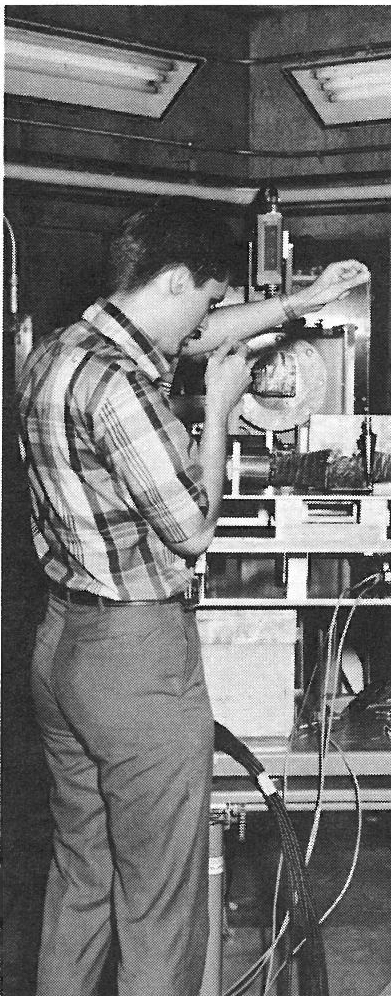
At the commencement exercises in June, 64 Ph. D. candidates were awarded their degrees and, in addition, 208 Masters' degrees were awarded: 14 Master of Education degrees, 11 in Urban and Regional Planning, and 183 Master of Science degrees.
Under the leadership of Dean Fred W. Bull, now completing his first year as dean of the Graduate School, an increasing effort is directed to the strengthening of the curricula and the addition of research-oriented faculty with teaching experience. Dr. Bull is former director of the Engineering Experiment Station, and thus is in an excellent position to properly relate graduate education and the research programs.
The continuing process of curricula revision designed to keep present graduate study abreast of rapid educational advances in all areas requires persistence and patience. But the effect is apparent in the rising quality of the university's graduate education programs.
Competition for federal scholarships, fellowships, traineeships, and research grants intensified in the year now ended. But the competitive pressure results in rising standards and greater depth in all of the graduate areas.
The progress achieved in improving the universtiy facilities for graduate research and teaching also is noteworthy. Development of the V.P.I. Molecular Structures Laboratory, financed by a $300,000 gift from an anonymous donor and announced last year, will substantially strengthen teaching and research programs in the life sciences, physical sciences, and engineering. The enlargement and expanded capability of the Computer Center is another example of continued improvement of facilities for the enhancement of graduate education.
Also of importance was the continued effort to assist graduate teaching assistants to achieve notable levels of competence in their teaching duties. The seminars and conferences, along with individual department programs, are effective in the professional development of the new teacher. This type of program is essential to maintain the high level of instruction required at V.P.I., and many graduate students are developing into excellent teachers.
As was noted a year ago, the recruitment of university faculty members who are committed to excellent teaching and who also seek the opportunity for significant research is essential. Much progress has been made in faculty recruitment, and its effect on the university's graduate programs is very apparent.
Two new degree programs at the Master's level were approved during the year, to become effective in the fall. These are in English and history. Additional degree programs at the graduate level will be formulated in the months ahead.
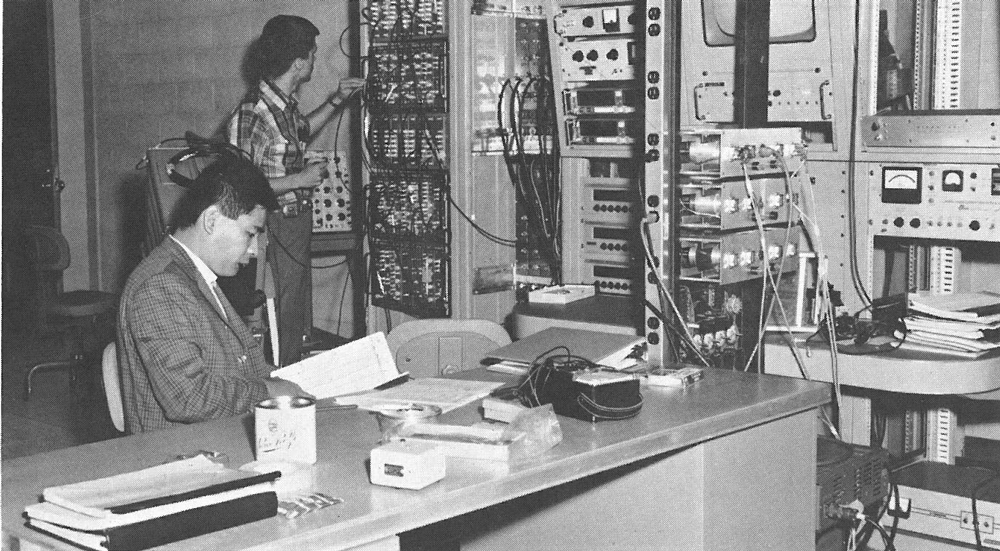
Research
The rising tempo of technological change in the national economy generates a variety of reactions; the continued impact of new data and techniques flowing from the nation's laboratories is probably the most important single economic factor of our time.
For the transformation of new information into new materials, new products, new processes, new methods of utilizing and controlling energy, and indeed into entire new industries, has become quite rapid. There is little time lag between laboratory findings and their productive application.
And research inevitably generates new research; the answers to one unanswered question well may identify many new areas of productive investigation. The volume of research, and the resources being allocated to it, have been compounded over the past few decades in astonishing fashion.
As Virginia's land-grant university, V.P.I.'s research efforts are increaingly more significant as Virginia becomes more urbanized and industrialized. The demand for services -- to business and industry, to farm and farm-related supply and distribution firms, to rural and urban communities -- is increasing rapidly. The increase is in direct proportion to the growth of the state's economy. It will develop at an even more rapid rate as Virginia consolidates its industrial growth, and the need for additional research efforts becomes more apparent.
For research is the basis of continuing technological improvements in industry, business, and agriculture. It is equally important in development of the university's instructional programs, particularly at the graduate level.
In the year now ended V.P.I. has been analyzing carefully the internal organization of its research activities in the light of the institution's growing research efforts. Legislation changing the legal basis of the two traditional research agencies on the campus -- the Agricultural Experiment Station and the Engineering Experiment Station -- was enacted by the 1966 General Assembly.
The new legislation created the university's Research Division. In the fiscal year now beginning all external funding and budgeting procedures involving research will flow through the new division structure.
Planning also has been under way for the internal administration of the new research structure. In the late spring a continuing series of conferences began to develop a formal structure for university research administration. The administrative organization will take final form and begin functioning as an overall research division early in the year now beginning.
The Engineering Experiment Station, established as a separate research agency by the General Assembly in 1950, administers the research programs for the Colleges of Business, Architecture, Engineering, and most of Arts and Sciences. The Agricultural Experiment Station is part of the national system of agricultural experiment stations supported jointly by state, federal and private funds. It dates back into the 19th Century, and is very much a factor in the very rapid increase in Virginia's agricultural productivity since the turn of the century. The Station also administers the Home Economics research programs.
Related organizations such as the Water Resources Research Center, the newly organized Center for Operations Research, and other units also are heavily involved in research activities. So is virtually every teaching department in the university. The volume of research activity now totals approximately 6.5 million dollars each year. New funding for agricultural and related research totaled about a million dollars in the year now ended. State and federal appropriations for research activities total about four million dollars annually.
These appropriated agricultural research funds permit the development of research designed to solve the problems of farmers and forest owners and farm related business and industry. Much of it involves commodity research, aimed at resolving problems of immediate concern to farmers and processors. The state appropriations for the biennium now beginning were not increased as much as was requested, but there is room for continued progress in the years immediately ahead.

Similar growth is occurring in the Engineering Experiment Station. New research funding during the year totaled about $785,000. State appropriations for the new biennium, nearly $500,000, more than doubled previous appropriations. Appropriated funds, used as seed money in research efforts, typically generated more than $4 for each state dollar invested. The volume of research activity in the immediate future can be expected to increase substantially.
The university's research activity covers a broad variety of investigations. Hundreds of professional scientists participate in research along with their teaching responsibilities; others are involved in full-time research. They serve on regional and national technical advisory committees and cooperate with many federal agencies. A number have been working in overseas assignments.
Illustrative of the larger research contracts awarded during the year was a $20,000 contract with the Highway Research Board to investigate the effects of salt and other ice-melting chemicals on roadside shrubbery and vegetation. Others included a $175,000 National Aeronautics and Space Administration (NASA) grant for research in high energy physics, and a $110,000 NASA multi-disciplinary space related research project. Another $100,000 U. S. Forest Service project involves a study of the economics of the Southern Appalachian hardwood industry.
But many hundreds of individual projects are constantly being initiated during the year, ranging from -the development of new foods to insect control and electrical transformers. An inter-disciplinary research project involving Mining Engineering and Animal Science, for example, is now investigating the possibility of adapting techniques used in separating minerals to separate x and y spermatozoa, to permit control of sex in animals. The extremely significant investigation of anerobic bacteria and the development of a reference collection of these intestinal bacteria is continuing. Careful laboratory work this past year successfully identified the causative agents involved in a destructive turkey disease.
The new leadership of the experiment stations will insure their continued progress. Dr. Coyt T. Wilson is completing his first year as director of the Agricultural Experiment Station, and Dr. William B. Harrison became director of the Engineering Experiment Station in late November. Dr. Harrison came to V.P.I. from the Georgia Institute of Technology, where he was head of the nuclear division of the Georgia Tech Experiment Station and director of the School of Nuclear Engineering.
The planning for the growing research programs also involves the expansion of the services which the Research Division can provide in order to nurture the growth of research. One very high priority item is the provision of centralized machine and electronic shops in which tasks which transcend the capability of departmental shops may be performed. There is no intent to replace departmental shops or to curtail their operations. A centralized shop, however, will augment their ability to provide operations of greater complexity and very high precision. Both the centralized machine and electronic shops should have the capability for design, fabrication, calibration, and maintenance of research equipment. A beginning has been made on both of these shops, and it is expected that considerable improvement will result during the year now beginning.
The programs of the Engineering Experiment Station and the Agricultural Experiment Station will continue under the new Research Division with better coordination and greater efficiency. The potential for significant advances in the research programs at V.P.I. is vast enough to stimulate excitement, and both the competence of the faculty and the prevailing attitudes of cooperation hold promise of very rapid achievement.
Extension & Community Colleges

A series of developments during the past year indicate a changing approach to many areas of the university's public service efforts and outline an emerging pattern of V.P.I.'s extension and branch college programs.
The new state-wide system of community colleges, the state-federal technical services program, the 1966 legislation broadening the university's extension activities, and other factors have served to refocus V.P.I.'s public service activities.
In the fall of 1965 the State Technical Services Act was approved by Congress and the President, creating a state-federal program designed to provide technical assistance to business and industry. V.P.I. was designated the administering agency for the program in Virginia, in cooperation with other qualified institutions. The State Council of Higher Education was designed as the review and coordinating agency for related programs.
An initial $25,000 grant was made available to help initiate the program, and both state and federeal appropriations have been made for the program for the year now beginning. Dr. Roger L. Smith, who currently is directing the V.P.I. Self-Study, also is planning director for the technical services program. It is emerging, in effect, as a type of business and industrial extension program, designed to channel technical information from the state's colleges and universities into the operations of business firms and factories throughout Virginia.
With the planning accomplished and an annual budget of approximately $200,000, it will be possible to implement the new program early in the year now beginning. Planning has been systematic, for a sound beginning is essential; as the program achieves momentum, it will be extremely important to the state's economy.
The beginning of the technical services program provides an opportune time for a review of all of V.P.I.'s extension activities. For some time the university has attempted to better relate its extension work to the social and economic changes occurring in Virginia. Consequently, legislation was enacted by the 1966 General Assembly creating a university Extension Division for the administration of all V.P.I. extension activities. This legal change was effective with the year now beginning, and, externally, all budgeting and fund allocations will be through the university-wide extension agency.
Internal planning also is under way for restructuring the extension functions in one organization, including Cooperative Extension, general extension, the state technical services program, and the operation of the Continuing Education Center, now under construction. The university's leadership groups are now formulating an appropriate organizational structure and basic guidelines for the extension programs. At this point it would appear desirable to include many of the university service groups in the overall extension organization, particularly much, if not all, of the spectrum of informational services. These activities can be extremely significant both to the university's instructional and research programs, and to Virginians throughout the state.
The agricultural extension program is conducted jointly by V.P.I., the federal government, and communities throughout Virginia. It has functioned effectively since its inception in 1914, disseminating information and assistance for the development of agriculture, home economics and work in related areas. Last fall Dr. William E. Skelton, associate director, was named director after the retirement of William H. Daughtrey, who had joined the staff in 1927.
Also the name of the Agricultural Extension Service was changed to Cooperative Extension Service, indicative of its cooperative sponsorship and the changing emphasis of its programs. Because of the increasing urbanization of Virginia and the state's changing economy, Cooperative Extension is broadening its programs and increasingly is concerned with urban and suburban problems, as well as its traditional work in agriculture. The legislation enacted last winter facilitates extension programs in the cities as well as in rural and urban counties.
In cooperation with other state and federal agencies and local groups, the Service in recent years has made increasingly important contributions in such areas as land-use planning and zoning, natural resource use and conservation, housing and community facilities, leadership development, recreational programs, civil defense, and work with low-income families.
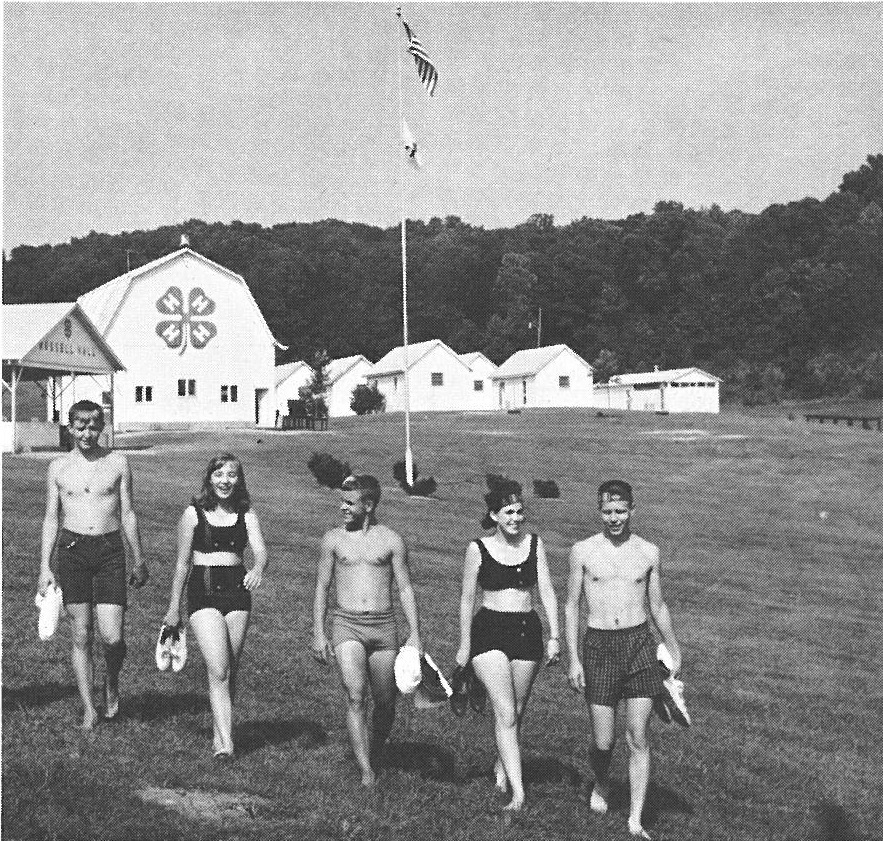
Its 4-H programs and related educational activities are enormously beneficial to the state's young people, and the home economics extension work has helped provide knowledge and skill for effective home management and consumer purchasing for thousands of families. Home Economics extension activity this past year placed its major emphasis on assistance for young married couples, working wives, lower income groups and elderly persons.
Cooperative Extension's service to agriculture and related farm supply, marketing and distribution industries remains a basic part of its mission. Agriculture in this sense is the state's largest and most diversified industry, with a gross product last year of 2.2 billion dollars. As with other industrial growth in the Commonwealth, the industry is changing rapidly, and Cooperative Extension must continually adapt to its changing needs. Extension personnel in the past year, for example, have been heavily involved in demonstrating new methods of fruit and vegetable culture and harvesting, conducting feasibility studies in marketing and manufacturing areas, and assisting in the formation and operation of organizations concerned with technical problems and technical information. A coordinating unit was developed to assist manufacturers and users of agricultural chemicals, and many members of the field staff received indepth training in farm management. Both graduate study and in-service training for the staff are of increasing importance.
Cooperative Extension agents are located in each county in Virginia, and as the thrust of the university's extension program broadens, the field staff can be organized to bring a wide range of university resources into use in resolving problems and providing technical assistance. Agricultural extension, of course, will continue, but the public service opportunities for the entire university are extraordinary. They will become more so as Virginia continues its social and economic development, and the state technical services program develops.
The university's general extension program continues to provide refresher courses for business and industrial groups, both on campus and in locations more convenient for those who take them. A particularly interesting innovation in extension instruction was developed during the year with a "telelecture" system. For example, a course was given to employees of the West Virginia Pulp and Paper Co. at Covington by a professor from his office at V.P.I. The system is essentially a two-way telephone hookup, with the electrowriter duplicating and projecting on a screen in the classroom the material written by the teacher in his office. With two-way oral communication, plus the visual presentation, the long distance teaching proved extremely effective. Other such courses will be organized as necessary.
Construction is well under way on the new Donaldson Brown Center for Continuing Education, which will provide modern facilities for on-campus intensive courses, conferences, and similar activities. Without the facility, however, the volume of summer conferences and courses at the university-aside from its regular summer sessions-is rapidly increasing. The center will make possible many more such activities throughout the year.
The new community college system, created by consolidation of the state's technical college program authorized in 1964 and many of the existing branch colleges, envisions a state-wide network of comprehensive community colleges. It was a major recommendation of the Virginia Higher Education Study Commission.
The need for much broader educational opportunities for Virginia's young people cannot be disputed. Virginia's total educational system clearly must be expanded in response to both the state's rapid population growth and the rising educational expectations of greater numbers of Virginia's young people.
Although V.P.I. was reluctant to see the branch colleges it had developed and nurtured leave the university system, there appeared to be no reasonable alternative consistent with the best interests of the Commonwealth and its citizens. The university supported the proposed legislation, and after its enactment cooperated closely with State Department of Technical Education and the new State Department of Community Colleges which is replacing it.
Roanoke Technical Institute, the V.P.I. branch college in Roanoke, was transferred to the Department of Community Colleges, effective July 1; it was combined with the two-year program of the adjacent University of Virginia extension center. The V.P.I. branch colleges at Wytheville and Clifton Forge-Covington will be transferred to the state-wide system July 1, 1967. Danville branch college will remain a part of. V.P.I., and ultimately will develop as a four-year college; Danville Technical Institute will be developed as the community college in Danville.
The university will permit students in college transfer programs at Roanoke, Clifton Forge-Covington, and Wytheville to move to the main campus at Blacksburg as V.P.I. students during the year. After July 1, 1967, students from the three colleges will be considered transfer students, as are students from other colleges and junior colleges. The status of Danville branch college remains unchanged.
Thus in the year now beginning, V.P.I.'s instructional responsibilities will continue at three of the branch colleges. Enrollment last fall totaled more than 1,500, including approximately 500 at Roanoke, 420 at Danville, 280 at Clifton Forge-Covington, and 350 at Wytheville. Similar enrollments are expected in the fall, although the enrollment pressure is not quite as great as it was a year ago. Not all of the students, of course, are in college transfer work.
The programs include two-year terminal courses, nurses training courses, secretarial science courses, and similar work. A particularly interesting program is the pre-college preparatory work, in which late maturing students can clear up deficiencies in their academic work and can be admitted to V.P.I. or other colleges. Some of the branch colleges also are holding summer institutes for college bound students, to help them better meet the demands of college work.
The first class of 125 college transfer students enrolled as full-time day students at Roanoke Technical Institute in September. Of these 79 will return to RTI in the fall; 40 have been transferred for their sophomore year at V.P.I. Others will attend other colleges this fall. Some 40 students at Roanoke received the associate degree in applied science after completing the engineering technology programs in June. They were able to select from 350 job opportunities with an average starting salary of about $520 per month.
Danville Community College, now the Danville Division of V.P.I., functions in a modern building constructed two years ago. It similarly has a very high demand for its associate degree graduates, and also has a large college transfer program. A new building to house a student lounge, the library, a biology laboratory and additional classroom and office space will be constructed in the coming year. With a current faculty of 18, the college's educational programs are of rapidly increasing value to the community. Its chemistry faculty, for example, serve as consultants for the operation of a chemical testing laboratory for the Dibrell Brothers Tobacco Co.
Wytheville Community College has made very rapid strides since its establishment in 1963; it has grown from 110 students and faculty members to some 425 students and faculty of 25. The community has invested approximately $420,000 in the College, and a new site has been made available for construction of a new campus. The existing building, made available by Wythe County, will revert for use as a county office building after new facilities are available. It is very much a community college; most of its students come from the surrounding area.
At Clifton Forge-Covington, 26 college transfer students completed their first two year's work in June, the nurse's training program in conjunction with the C & O Hospital Nursing School provided the academic work for 28 students, and the two-year secretarial science program graduated its first class. The college has made outstanding progress since it opened two years ago. Its adult education programs provided a series of art courses for the community this past year which were extremely well received. Currently, it is offering a summer institute for students entering college in the fall.
After the coming year all of these colleges except Danville will function as part of the state's community college system. Their development well demonstrates that the location of a community college in a locality which had not previously had facilities for education beyond high school tends to enlarge the educational aspirations of many more students. Adults, too, often seek additional educational opportunity.
In all of its extension and public service work, V.P.I.'s goal is better service to Virginia and Virginia citizens. The year has provided much opportunity for such service, and the opportunities are increasing rapidly.
Campus Growth
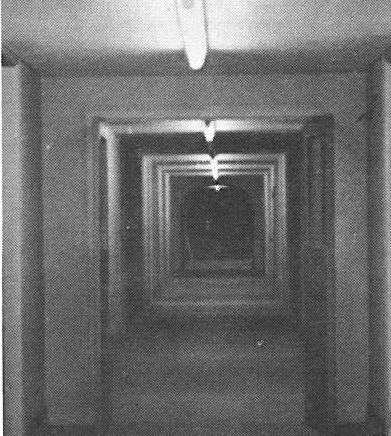
Some of the overt enthusiasm and excitement apparent on the V.P.I. campus is reflected by the physical fact of growth. The university plant is growing; it must if a reasonable proportion of the students seeking admission are to be accommodated. Also, the strengthening of the instructional, research and public service programs necessarily requires more adequate facilities. Without the concurrent development of the university's academic programs, the expansion of the physical plant would hardly be worth the effort and the substantial capital investment required. The economic and social complexities of our time demand educational opportunity appropriate for an uncertain future.
The magnitude of the plant expansion required for the university's rising enrollments and expanding academic programs is quite large. Enrollments are following very closely the projections previously made, which anticipate 12,000 students on the campus by 1970, and 15,000 by 1975. The six-year capital outlay program developed to permit such growth (1966-72) envisioned capital outlays from state funds of approximately 31 million dollars, in addition to dormitory and other construction financed by revenue bonds totaling about 19.6 million dollars. Nearly 5 million dollars, also from state sources, was anticipated for capital construction for the research stations.
The construction program doubtlessly will be revised substantially as it progresses. With the continuing construction of the new Lane Stadium, financed primarily from gifts, the construction program already totals more than 25 million dollars.
The physical features of the campus are changing very rapidly under the impact of such a construction program. As has been noted, nearly 10 million dollars was appropriated for new buildings and related construction for the biennium now beginning. Appropriations also were made for preparation of architect's plans for two additional classroom and laboratory buildings for which the total costs are limited to 2.5 million dollars and 2.2 million dollars, respectively. Construction appropriations for the two buildings are scheduled in 1968. The 1966 General Assembly also authorized revenue bond financing for an additional 1,250-student dormitory and a third dining hall. Approximately half of the 3 million dollar renovation and expansion of Squires Student Center also will be financed by revenue bonds. New buildings rising against the skyline will be a continuing feature of the campus for some years to come.
Three high-rise dormitories were under construction as the year ended: O'Shaughnessy Hall, Lee Hall, and Pritchard Hall. They were named, respectively, for Dr. Louis O'Shaughnessy, Prof. Claudius Lee, and Dean Samuel R. Pritchard, all distinguished former faculty members. The three buildings will house about 2,500 students.
A smaller dormitory, Johnson Hall, was completed last winter; it houses about 185 students. Johnson Hall, along with four other dormitories completed since the summer of 1962, Barringer, Miles, Newman and Vawter Halls, were dedicated during the spring. They were named for five men prominent in the university's development: Col. J. S. A. Johnson, Paul Brandon Barringer, C. P. (Sally) Miles, Dr. Walter S. Newman, and Charles E. Vawter Sr. Dr. Newman, president emeritus, still lives in Blacksburg; Dean Miles died only a few weeks before the dedication. J. Ambler Johnston, a 1904 Tech graduate, whose architectural firm designed the dormitories, was the dedicatory speaker.
The new dormitory construction and renovation program was financed last year by a 9.6 million dollar bond issue. It includes the renovation of Eggleston and Campbell Halls, men's dormitories, for use by women students. The east and central wings of Eggleston will be available for women students this fall. West Eggleston will be completed this winter. Campbell Hall also will be closed in the winter, so that it can be converted for women's housing. Construction of a fourth large dormitory, and the additional dining hall, under the revenue bonds authorized by the General Assembly, will get under way next year.
Also under construction as the year ended was the Donaldson Brown Center for Continuing Education, financed partly by state appropriations and partly by thousands of individual gifts over a period of some years. The construction involves the renovation of the old faculty apartment building, plus a major addition. The facility will be available for use by the summer of 1968.
A major university improvement also is the construction of a new 4,200-foot runway for the V.P.I. airport, graded to 4,400 feet, and the installation of lighting equipment. The $600,000 project was financed partly by federal funds, partly by allocations from the State Division of Aeronautics, and partly from gifts. The construction is nearing completion.
The west stands and press box facilities of new Lane Stadium were virtually completed last fall; the facility was used for the season's football games. The first-phase construction of the east stands is now nearing completion. The total stadium cost thus far is almost 1.4 million dollars, and was financed largely by gifts as construction proceeded. Ultimately the stadium will seat some 45,000 persons.
Other projects under way or completed in the year include a $200,000 laundry addition, a $290,000 greenhouse addition, a series of utility and site improvement items, and the renovation of the former Blacksburg high school and elementary school buildings. The public school property was acquired at a cost of approximately $300,000. The availability of the school buildings for temporary use during the construction program has been of critical importance.
Included in the construction just beginning or soon to begin is a 3.7 million dollar classroom-laboratory building for arts and sciences; the 3 million dollar addition and renovation of Squires Student Center; a million dollar addition to Burruss Hall, the administration building-auditorium; a million dollar architecture building; a 1.1 million dollar home economics building, and a $720,000 addition to the food processing laboratory.
Contracts will be awarded for all of these buildings during the remainder of the summer and fall. Because of the continued rise in building construction costs there undoubtedly will be major problems in obtaining bids within available funds. Hopefully they will be resolved. Former Governor Harrison's action making available planning funds last fall from several new construction projects, and the emergency capital outlay appropriations made by the General Assembly permitted more rapid progress on them than would have otherwise been possible. But construction costs are rising some 10 per cent each year, and the higher cost will remain a major difficulty as the capital outlay program proceeds.
In addition to McBryde Hall, many of the frame buildings erected for emergency use during World War II also will be razed. The buildings and grounds shops immediately behind Burruss Hall similarly will be torn down in site preparation for the architecture building.
The Department of Buildings and Grounds is being relocated in temporary locations throughout the campus. Portions of it temporarily will utilize V.P.I. owned houses, the pressing and cleaning shop, and other facilities. Construction on a new building to house this major department w'i!l begin in the near future.
The construction program necessarily involves the relocation of many activities. The engineering drawing classrooms have been temporarily located in the older part of the infirmary building. Some faculty offices will be located temporarily in War Memorial Gymnasium and in the remaining university owned houses on campus. Many classrooms and laboratories are somewhat crowded by the relocation of classes and faculty offices. The inconvenience is considerable, but necessary, to accomplish the university's growth.
The rapid growth of the university and the magnitude of the construction program require very careful planning. If such planning is not done, the realizations of immediate and short range objectives easily may create severe problems for long range development. In the winter, the university's revised site plan, prepared by Carneal & Johnston, architects and engineers of Richmond, and Architects Collaborative, of Cambridge, Mass., was completed. It was based on the university's projected growth in the decade ahead, and the development of the university's academic program.
The major emphasis of the plan is for the functional use of classroom and laboratory space, rather than assigning specific buildings to particular departments. Thus, general purpose classrooms and laboratories would be located as close as possible to the dormitories to alleviate some of the central campus congestion.
The drill field will remain the focal center of the campus and a plaza behind Burruss Hall will become the center of the academic area. Future academic buildings, will expand northwesterly from Burruss Hall. Parking would be generally available in outlying areas, and the plan suggests that eventually it may be necessary to develop a shuttle bus system for campus transportation.
A major factor in future campus planning will be the development of a four-lane divided highway west of the campus, through the university's farms. The highway, a U.S. Route 460 by-pass for Blacksburg, will provide much better access to the campus. Its connection with Interstate 81 in Christiansburg and the development of Route 460 as a part of the Virginia arterial highway system will enormously improve highway access for the university.
There are many other features in the basic site plan. An important one is the more intensive use of classrooms and laboratories; space utilization, already high, will increase by some 50 per cent. But the plan preserves the ability of future university administrations to develop the university to whatever size is necessary, or alternatively, to plan clusters of small campus units around the main campus.

Broadening Support
The receipts of the V.P.I. Educational Foundation totaled $3,557,452 in the past year, an increase of nearly a million dollars from the previous year. They have been climbing steadily for several years; in 1962-63 the total was about 1.2 million dollars.
The Foundation is the legal repository for a variety of funds contributed or otherwise received by the university. It receives and disburses alumni contributions, private and corporate gifts, federal grants, scholarship funds, and similar accounts. Most of the funds are earmarked for speciflc purposes.
The rising trend of non-state support is of course encouraging. As the university's development progresses, however, and continuing efforts are made to strengthen all of its components, the need for additional support will become even more critical. State appropriations now account for only a little more than 40 per cent of the university's current 26 million dollar annual budget. Despite substantially increased appropriations for the biennium now beginning, the proportion will not change significantly in the next two years.
This is true, of course, because of the university's growth, and the concurrent necessity of strengthening its instructional and research programs as well as its public service activities as resident enrollment continues to rise.
In reviewing the university's present programs and their relative need for additional financial support, additional scholarship funds and library resources appear to demand priority.
All of the colleges advise of the critical need for additional scholarships. Both an increase in the number of scholarships available, and the creation of a series of scholarships which would cover most of the college expenses of their recipients, would be extremely beneficial. The university now is not attracting sufficient numbers of outstanding students, young men and women capable of obtaining scholarship assistance at any major university. More of them should come to V.P.I. And larger numbers of capable students without adequate resources should be provided assistance so that it will be possible for them to continue their education here.
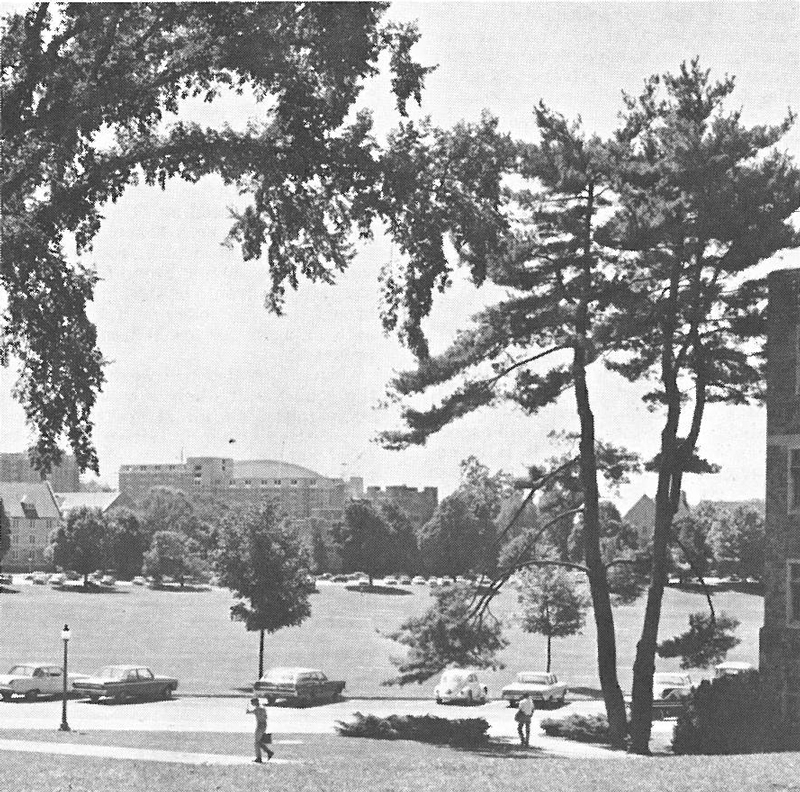
Mention has been made of the rising level of state support for library development, particularly for book purchases. The heart of the institution, of course, is its library. Substantial support beyond that available from appropriations is essential. The rate of V.P.I.'s growth, and its broadening academic and cultural base, require all possible effort for more rapid improvement of library resources. The scope and quality of expanded educational efforts ultimately will be limited if this is not accomplished.
These are the university's two major development objectives for the year now beginning. Their achievement will play a crucial role in the university's capabilities for service in the years ahead.
For the past year the broadening support of the university indicates a wider recognition of its development and its services to Virginia and the nation. In the calendar year ended last December 31st, alumni contributions totaled more than $1,010,000; the figure for the previous year was about $290,000. Several major gifts were partly responsible for the dramatic increase, but nearly 8,000 alumni participated. All areas of alumni support were included.
For the fiscal year now ended, alumni contributions totaled almost $900,000; there is good reason to expect the current calendar year total again will exceed a million dollars. Certainly, it is essential that much larger numbers of alumni and alumnae participate in support programs for the university, both because of the financial need and the opportunity to participate in alumni activities on the campus in their home communities.
A number of developments should be included in a review of the financial assistance made available for V.P.I. in the past year. Last fall, the Rockefeller Foundation provided a $100,000 grant for scholarships assistance for V.P.I. students. Twenty-five, $500 four-year scholarships have been awarded for the upcoming school year, and an additional 25 will be assigned in the fall of 1967. The program primarily is designed to help young people of high potential ability from a disadvantaged home environment to obtain education beyond high school. Many of the students will be Negroes. Other assistance also will be available, such as loan funds, employment opportunities, and special counseling programs.
In a related program, a $116,268 grant from the U.S. Office of Economic Opportunity has financed an "Upward Bound" project for 100 high school juniors and seniors. The students, from much the same socio-economic group for which the Rockefeller grant was designed, will be brought to the campus for six weeks each summer for specialized educational programs.
Counselors also will work closely with the students in their schools and home communities in an effort to offset to some extent their initial social and cultural handicaps. By the selection of potentially high achieving students for university work, the program will make it possible for many of them to obtain educational experiences that otherwise would not be possible. Many of these students will become eligible for the Rockefeller scholarships.
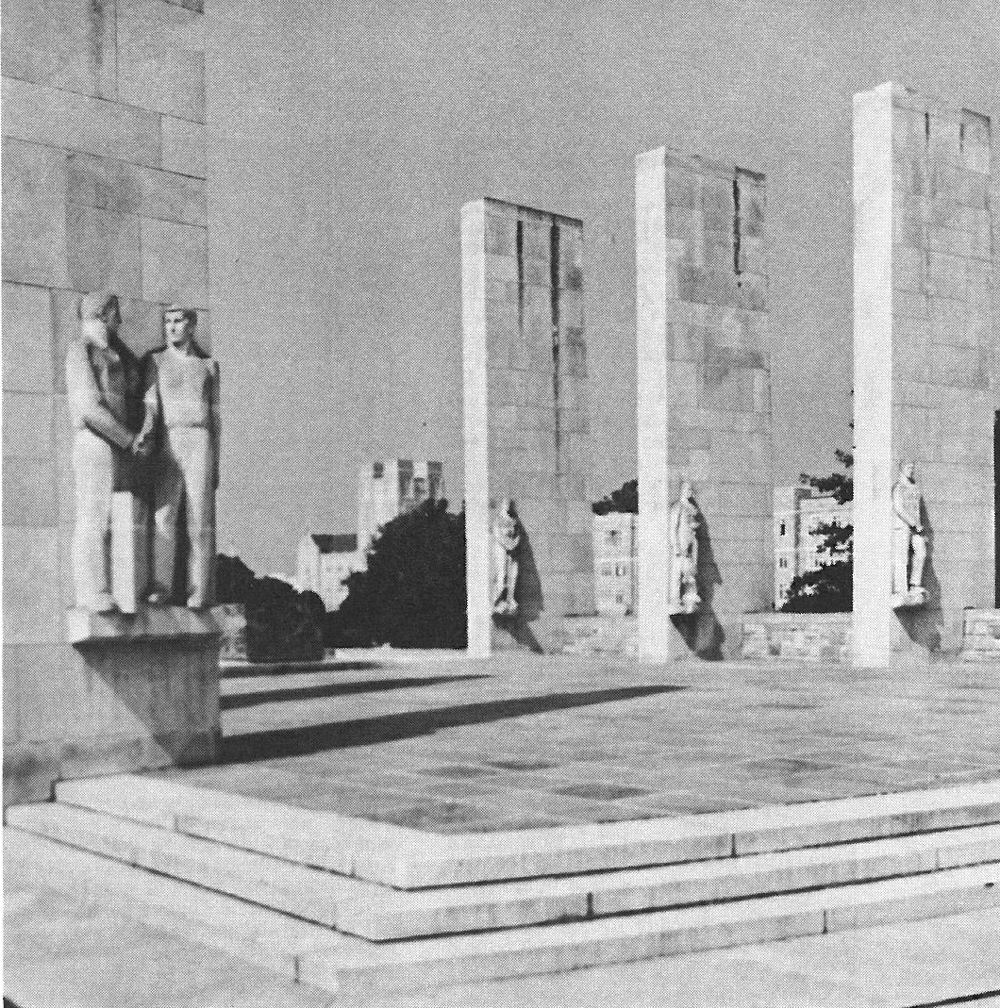
Also the year saw the beginning of an endowment fund for the university. One $500,000 gift, an undesignated fund, has been set aside for the beginning of an endowment. Other large gifts and contributions will be added from time to time as they become available. Until the fund has reached a substantial sum, all of its earnings will be added to the principal. In this way a major source of income will be developed in the years ahead for strengthening university programs for which funds otherwise would not be available. The lack of a substantial endowment for the university in past years has been a major deficiency in the development of the university.
As has been noted, several major projects in the university's development efforts were quite successful during the year; construction is continuing on Lane Stadium, the airport improvement project is nearly completed, and construction of the Donaldson Brown Center for Continuing Education is well along. The purchase of land for the development of University Research Park, in which there is now increasing interest, has now been accomplished with private support. A regional Forestry Service Laboratory will be located in the Park, and some very significant negotiations for continued development are now in progress.
But these efforts constitute only a beginning. With wider recognition of V.P.I.'s development, and its increasing ability for significant service, much broader opportunities for private financial support will become available. Certainly, without substantial support beyond that available from the Commonwealth, the progress which the university can make will be less certain and far slower.
Alumni Affairs
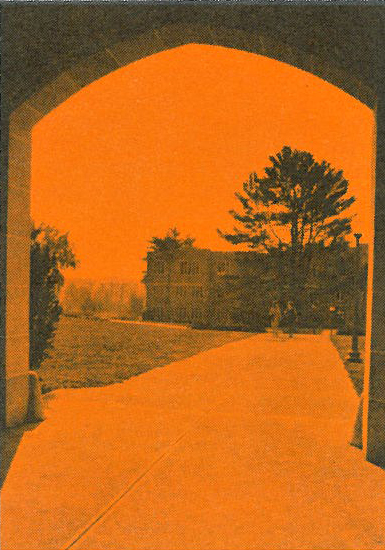
As the university's transition progresses and its new patterns of growth develop, its alumni programs and activities necessarily assume a larger importance. For the alumni group grows substantially each year; it now totals nearly 28,000, including well over 1,300 students who completed degree programs in June. The steadily increasing enrollment at V.P.I. and the larger graduating classes increase the younger components of the alumni family. Far more university alumni attended V.P.I. in the years following World War II than before. But all components of the alumni group are increasingly important in its activities; the loyalty and dedication of the older groups more than offset their declining numbers.
The growing financial support of the university by its alumni and alumnae has been discussed in previous sections of this report. It is clear that much larger numbers of alumni must be encouraged to participate in the university's growth, both financially and with their active support in their home communities.
It has long since become apparent that a closer working relationship must be developed for both the V.P.I. Alumni Association, individual alumni, and the university.
There are, of course, diverse opinions within the alumni group regarding the university's objectives. The differences of opinion concerning the Board of Visitors' action in 1964, making membership in the Cadet Corps an elective option, is an example. It is apparent, however, that the university has achieved a better understanding of the necessitv of its growth and the changes required to better relate its development to the educational needs of Virginia. There is no more urgent requirement than for V.P.I. and its alumni to work more closely to help provide greater educational opportunities so essential for Virginia's young people. Neither the universitv nor the alumni can accomplish their greatest good without close cooperation.
Continuing efforts in this direction have made substantial progress. As the year closed, the executive committee of the Association's Board of Directors announced appointment of a new Director of Alumni Affairs, effective July 15. He is C. Bruce Ross Jr., a member of the class of 1957, at the time of the announcement electric heating products manager for the U.S. Gypsum Co. in Chicago. Ross succeeds M. L. Oliver, who resigned in the fall to become associate placement director.
The Association's executive committee also announced its approval of the plan to relate alumni activities more closely to the development of the university. It involves the designation of V.P.I.'s dean of students, Dr. James W. Dean, to serve as principal liaison between the university administration and the Alumni Association. Dr. Dean will work closely with the new alumni director, the Association Board, and individual alumni chapters. The program is designed to generate a cooperative effort by the administration and faculty and by the alumni group to develop a more productive alumni-university program.
Somewhat more than half of V.P.I.'s alumni and alumnae now reside in Virginia. Other graduates can be found throughout the United States and in many parts of the world. The largest out-of-state groups are in the eastern and northeastern United States, the midwest, the southwest, and on the west coast. University administrative and faculty members are frequent speakers at alumni functions, and Athletic Association representatives also frequently meet with alumni groups. This contact will be strengthened in the years ahead in an effort to organize new chapters and to generate a greater interest in organized alumni activities.
A film depicting the highlights of the activities on the campus during the past year was produced by the university's film unit and the public relations office. It will be used in the orientation program this summer for new students and their parents. When prints are available in the early fall, the film will be made available for alumni programs.
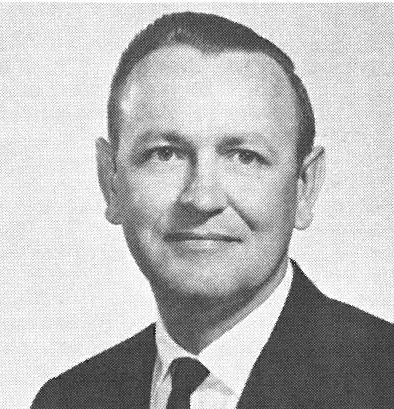
The opportunity to welcome back to the campus one of the university's most distinguished alumni, Christopher C. Kraft Jr., was one of the highlights of the year. Kraft, then flight director for the National Aeronautics and Space Administration's Gemini project-he has since been promoted-is a 1944 graduate of V.P.I. He is one of hundreds of university alumni now making major contributions to the nation's space programs.
The Board of Visitors authorized presentation of the university's distinguished alumnus Citation to Kraft at a special convocation and weekend in his honor. Gifts of an original painting used for a Time magazine cover story on Kraft and a Steuben glass eagle were provided for presentation to Kraft. In addition, the Corps of Cadets presented him with a replica of their cannon, and the Civilian Student Body gave him an engraved pewter mug.
The opportunity for more productive and meaningful alumni work by the university and the alumni groups is almost unlimited. The changing relationships now apparent, and the structuring of a closer liaison between the university and the Association, hold promise of much greater accomplishments in the years ahead. There was no more significant development on the campus in the past year.

For The Record
Virginia Polytechnic Institute's 94th annual commencement was held June 12 in the university Coliseum. A total of 1,336 baccalaureate and advanced degrees was awarded, the largest such graduating class in Virginia.
Among the degree recipients were 991 awarded the Bachelor of Science Degree, 50 who received the Bachelor of Arts Degree (the first time the B.A. degree was authorized since 1886), and 23 who were awarded Bachelor of Architecture degrees. The Master's degrees awarded included 183 in Science, 14 in Education, and 11 in Urban and Regional Planning. The successful candidates for the Doctor of Philosophy Degree totaled 64.
Dr. Hahn, himself a "freshman president" in 1962 when the class of 1966 entered V.P.I., spoke briefly: "The successes and accomplishments of the university during these four years," he said, "have come in no small part because of the truly outstanding student body that is exemplified by the graduates here today."
The changes that have occurred during the past four years at V.P.I., Dr. Hahn suggested, are very much part of an era of change "for change has become the only constant in our time."
Commissioned during the reserve Qfficer commissioning exercises June 11 were 102 Army ROTC graduates and 72 Air Force ROTC graduates. Lt. Gen. John W. Carpenter III, commanding general of the Air University, Maxwell Air Force Base, was the commissioning speaker. Maj. Gen. William W. Beverley, the Army's director of enlisted personnel, administered the oath of office.
Appointments
Many outstanding teachers and administrators joined the university in the past year, and space does not permit an inclusive listing. As has been noted, approximately 20 per cent of the faculty and staff was newly appointed during the year.
Among the appointments, however, was that of Dean G. Burke Johnston to the newly established C. P. Miles Professorship in English Literature. Dean Johnston relinquished his administrative post to return to full-time teaching and research. Dr. Leslie F. Malpass of the University Qf South Florida succeeded Dr. Johnston as dean. Dr. Fred W. Bull also was named dean of the Graduate School, moving from director of the Engineering Experiment Station. Dr. William B. Harrison of Georgia Tech succeeded him.
Others who came to V.P.I. during the past year, Dr whose appointments have been announced for the year now beginning, included Dr. Wilson C. Snipes, professor of English at Mercer University, as head of the Department of English. He succeeds Dr. M. L. Peacock, who relinquished his administrative duties for full-time teaching and research. Dr. William A. Blackwell, professor of electrical engineering at Oklahoma State University, was named head of Electrical Engineering. Prof. Ralph Wright had been serving as acting head.
Dr. Alan G. Heath, assistant professor of zoology, was named assistant dean of the College of Arts and Sciences, and Dr. Joachim Bruhn, visiting professor of German at Duke University, was named head of the now separate Foreign Language Department. Dr. Wilson E. Schmidt, head of the Economics Department at George Washington University, was appointed head of the Economics Department.
Dr. William B. Harrison, former director of the School of Nuclear Engineering at Georgia Tech, has served as director of the Engineering Experiment Station since November. William R. Walker, assistant professor of Civil Engineering, was named director of the Virginia Water Resources Research Center last fall. Dr. Alan F. Clifford, associate professor of chemistry at Purdue, was appointed head of the. Chemistry Department. Dr. Luther K. Brice had been serving as acting head since the resignation of Dr. Robert C. Krug. Dr. Joseph L. Bernd, professor of political science, was named head of the now separate Political Science Department.
Dr. Ronald J. Patten, associate professor of accounting, was named head of the Accounting Department, and Dr. Sanford J. Ritchey, associate professor of Human Nutrition and Foods, became head of his department in June.
Carl E. Burke, a graduate of Niagara University, was named chief accountant for the university in the summer of 1965, succeeding Fred E. O'Connell, who resigned. William N. Sterrett, Henrico County public utilities director, also was named director of buildings and grounds last summer. Frank L. Butler last fall was named associate director of admissions; he had been teaching accounting.
Dr. William E. Skelton, associate director of Cooperative Extension, was named director in January. William A. Hamilton, publications editor for Cooperative Extension, was named head of Agricultural Information and Publications.
Prof. Robert H. Pusey was named director of the Cooperative Education Program last summer; he had been serving as assistant professor of chemical engineering. Also in the summer, H. Norvel Camden Jr., assistant professor of electrical engineering, was named assistant director of the program.
Marcus L. Oliver, director of alumni affairs, last fall was named associate placement director. C. Bruce Ross of Crystal Lake, Ill., a member of the class of 1957, was appointed to replace him.
Miss Martha Brown Harder, dean of students at Lander College at Greenwood, S. C., was named dean of women, effective July 15. David E. Hill was named assistant to the dean of men. A series of other staff members also was announced for the dean of students office.
Retirements
Among the faculty and staff retirements this past year were Dr. Thomas W. Hatcher, professor of mathematics, who joined the faculty in 1923. He had served as head of the Department of Mathematics in 1956-63. Prof. William P. Williams, associate professor of architecture, also retired at the close of the year, after 20 years service.
William H. Daughtrey, director of the Cooperative Extension Service, retired December 31, 1965. He had joined the extension staff in 1927. Miss Lucy P. Blake, assistant director of Cooperative Extension for home demonstration activities, retired September 1, 1965. Her death occurred in January. She had joined the extension staff in 1934. J. Russell Abbitt, director of buildings and grounds, retired October 31, 1965. He had been director since 1945.
Miss Clarice Slusher, associate registrar, retired January 31, 1966. She had served as registrar during 1937-63, and had joined the registrar's office staff in 1927.
Miss Mary B. Settle, professor and head of the Department of Management, Housing and Family Development, retired at the close of the year. She had been on the home economics faculty since 1922.
Other retirements during the year included:
Rudolph D. Michael, editor and head of the Department of Agricultural Information and Publications, retired November 30, 1965, after 37 years service.
Miss Gladys Johnson, assistant head of the library reference department, retired March 31, 1966, after 12 years service.
Miss Hetty A. Skelton, serials librarian retired June 30, 1966, after four years service.
Deaths
Dr. Benjamin O. Miller, professor and head of the Economics Department, died August 7, 1965; he had been on the faculty since 1928. Prof. William N. Renfroe, assistant professor of economics, died August 25, 1965, after six years service. Louis F. Volk, instructor of mathematics, died November 8, 1965; he had joined the faculty in 1964. Dr. A. B. Groves, professor of plant pathology at the Winchester Research Laboratory, died January 26, 1966; he had been in the university's service since 1929.
Extension Retirements
The following Cooperative Extension agents for agriculture and home demonstration retired during the year; their beginning service dates are in parentheses: Paul E. Bird, Wythe County (1926) ; Everette L. Phillips, Mathews County (1942); Stanley J. Dawson, Westmoreland County (1926); Richard S. Ellis, Buckingham County (1921); Mary E. Hagler, Bland County (1953); Conaway B. Haskins, Charlotte County (1949); Mrs. Kate Estes Hoge, Montgomery County (1943); and Margaret S. Svoboda, district agent, Salem (1933). Joseph M. Johnson, Carolina County (1940), died in May.
Finances
The university's total expenditures in the year ended June 30 was $25,569,434, an increase of about 3 million dollars over the previous year. Educational and general expenditures were approximately 21.3 million dollars, including about $964,000 for administration and general expenses. Scholarships and related student assistance expenditures totaled almost $600,000. Dormitories, food service and other auxiliary enterprises accounted for about 3.5 million dollars.
Total current fund income amounted to $26,224,071 for the year, an increase of about 3.5 million dollars over the previous year. The largest single source was state appropriations, which totaled about 10.7 million dollars. Federal funds accounted for about 4.8 million. Tuition and fees for educational and general purposes totaled 3.7 million.
The gross income of the auxiliary enterprises totaled about 4.4 million dollars.

Athletics
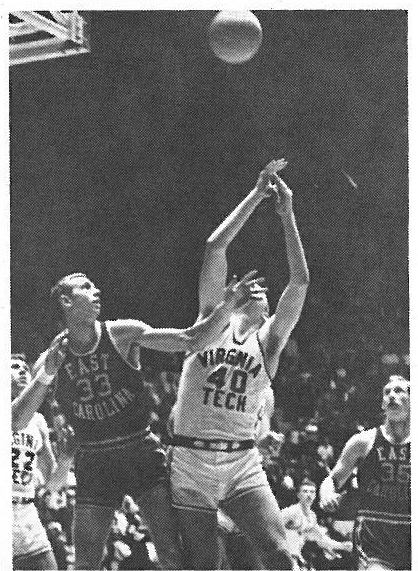
The intercollegiate athletic programs at V.P.I. are very much a part of the university's growth, and in the yea! now ended there was ample evidence that they were keeping pace with the continued development of the academic programs. For in athletics 1965-66 was one of the most eventful years in a good many decades.
The development of an outstanding athletic plant was part of it. The new stadium and coliseum were available, and a series of new all-weather tennis courts were completed. The varsity track events were held on an all-weather Grasstex track constructed near the stadium. The nine-hole golf course and a fine baseball diamond are excellent athletic facilities. And approximately 700 student athletes were participating in the intercollegiate athletic programs.
The university's objective is a balanced athletic program with high academic standards. In athletics as in academics, V.P.I. is becoming nationally competitive. The record of recent years and the athletic schedules now developed for the years ahead both show substantial progress in this direction. There arc many considerations involved in the university's efforts to strengthen its athletic programs, for the benefits of a successful program are diverse. Athletic activities involve many hundreds of student athletes, staff people, and others related in one way or another to the athletic program. And no activity of the university brings larger numbers of alumni, friends and visitors to the campus, or attracts greater attention in state and national news media. The athletic programs are valuable in themselves, but their contributions to other areas of university development also are important.
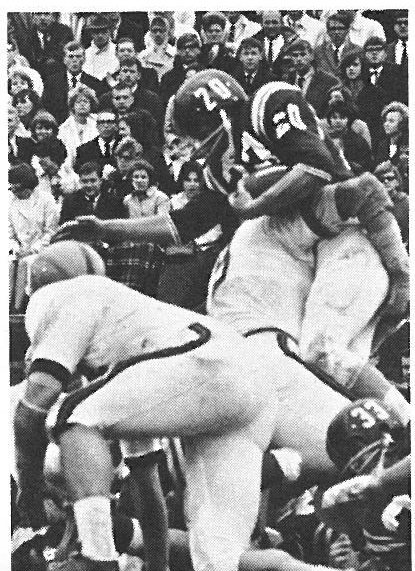
Consequently, as V.P.I. emerges in national distinction, the concurrent development of its athletic programs is essential. With proper leadership and planning, this goal can be attained with little danger that the emphasis on athletic activities will endanger the academic programs. The progress achieved in this direction in the past year was substantial.
Seven of the ten intercollegiate athletic programs at V.P.I. enjoyed winning seasons in 1965-66. In football, the Gobblers' 7-3 record against tough opposition was quite satisfying, and the outlook for the coming season is excellent. Arrangements were made for televising the Virginia Tech-Florida State game at Blacksburg October 29 on a television network covering the eastern section of the nation.
On the basketball courts, the V.P.I. team posted a 19-4 season record, and the university was nationally ranked for the first time in modern history. At the season's end V.P.I. was invited to compete in the National Invitation Tournament in New York. The university also was host for regional first-round competition in the National Collegiate Athletic Association championship games.
The track team, enjoying its best season in a decade, posted four wins to one defeat, and most of the other intercollegiate competition also was successful. And in the sports where the teams did not achieve a winning record-tennis, cross country running, and swimming - there was marked improvement from previous efforts.

An unhappy event in the year was the death of Dean C. P. (Sally) Miles, whose life spanned so much of the university's development in this century. As student, athlete, coach, athletic director, professor, and dean of the college, Dean Miles' contributions to the university were many. He was a founder of the Southern Conference, and Miles Stadium, opened in 1926 and replaced this past year with Lane Stadium, was named in his honor. One of the new dormitories dedicated in the spring also memorializes Dean Miles. Gifts and pledges for another memorial are now being received.
The university withdrew from the Southern Conference at the outset of the school year, and has since functioned as an independent. V.P.I. was the last remaining charter member of the Conference. Its academic and athletic development had progressed to a point where Southern Conference competition was no longer appropriate. The Atlantic Coast Conference, whose members are largely state universities, is now reviewing a proposal that V.P.I. be admitted for ACC competition.
One of the highlights of the year was the dedication of Lane Stadium, and with it the inauguration of an annual Governor's Day program at V.PJ. The Stadium was dedicated last October 23 during halftime activities of the game with the University of Virginia. The William and Mary game previously had been played in the still uncompleted facility.

Combined with the annual Homecoming program and the new Governor's Day activities, the dedication was quite successful. Albertis S. Harrison Jr., then governor, made the brief dedicatory speech. A capacity crowd of more than 30,000 filled the completed section of the stadium and the temporary bleachers on the east side of the field. The Gobblers, appropriately, defeated the University of Virginia.
The Governor's Day program is designed primarily to attract state officials, members of the General Assembly, and other guests to the campus. For many of them there is little opportunity otherwise to visit the university, and to become acquainted with its development and emerging academic progress. The Governor's Day events include a reception and dinner on the night prior to the game, a lunch on the campus, and attendance at the game.
Mention should be made of the extraordinary support provided for the construction of Lane Stadium. It is named for E. H. Lane of Altavista, recognizing his major support and leadership to the university and its athletic programs. Without a broad-based fund appeal, friends of the university have been providing gifts to finance the stadium construction as it progressed. It was necessary for limited short-term borrowing to meet construction schedules, but the financing of the stadium is very much a credit to the generosity of interested alumni and friends. No state appropriations are involved.
Following Dean Miles' death, Dean Wilson B. Bell of the College of Agriculture was named faculty chairman for athletics. Dean Bell had worked closely with Dean Miles, and his life-long interest in athletics made the appointment quite appropriate.
Earlier, the Association Board adopted a statement reasserting its policy of recruiting student athletes with high levels of academic and athletic ability, regardless of race. The statement was designed to reassure all student athletes that recruiting efforts for the university are made on the basis of ability and scholastic achievement and that race is not a factor in athletic recruiting. A number of Negro student athletes were included in the young men contacted this past year by members of the coaching staff.
The continued support of the university's athletic programs is most encouraging. Contributions to the Virginia Tech Student Aid Association for athletic scholarships in the past year totaled nearly $125,000. A year earlier the total was about $102,000.
Since V.P.I. withdrew from the Southern Conference last fall it has, of course, fielded its athletic teams as an independent. Because of pending efforts to attain membership in the Atlantic Coast Conference, the numbers of athletic grants-in-aid made each year are being restricted to comply with ACC rules.
In football, for example, the maximum number of new students permitted on athletic scholarships each year is 35. This tends to broaden the competitive sports in which student-aid scholarships are available. It also makes for more selective recruiting.
The evolving athletic program at V.P.I. is increasingly important for the university's development. The contributions of the athletic officials, coaches, and their staffs, are well recognized, both for the development of individual student athletes and to the physical education programs for all students. The athletic progress of the university in the year now ended has been consistent with other phases of university growth.

The Years Ahead
The pages of this report summarize in some detail the focus and direction of the growth of Virginia Polytechnic Institute, and the broadening scope and depth of its instructional, research, and public service programs. They outline the context in which the university is moving to accommodate larger numbers of Virginia students and to provide a better balanced social and academic environment for their work at V.P.I. They summarize, too, the planning that is being done for the orderly growth of the university.
Despite the difficulties involved in accurately forecasting future events and activities and in foreseeing future developments, the momentum and direction of the university's growth are reasonably clear. For as Virginia moves to provide for its young people the improved higher education that it must if it is to sustain its overall social and economic development, there is little question that V.P.I. will bear increasingly heavy responsibilities as Virginia's land-grant university.
Thus the pattern of V.P.I.'s growth as a university is well defined; it must continue to improve its academic programs for education in engineering, agriculture, business, architecture and home economics. The strengthening of its arts and sciences and humanities programs is essential, both for broader education in the professional fields, and for an appropriate liberal arts education for those seeking it. The preparation of teachers for all levels of education also will become an increasingly important development, as will the military training system.
V.P:.I.'s graduate programs clearly must be developed as rapidly as possible, contingent, of course, on considerations of substance and quality as they affect the numbers of graduate students on the campus. The rapid technological changes now apparent which so profoundly affect the state and national economy will provide a continued impetus for broader opportunities for education beyond the baccalaureate degree. And the growth of the university's undergraduate programs necessarily required substantial graduate departments and larger numbers of graduate students for teaching assignments.
Consequently as the university's academic reputation continues to be more widely known and its research programs develop, its ability to attract outstanding graduate students is considerably enhanced. This trend already is apparent. The growth of the graduate programs will progress very rapidly in the years ahead.
The same is true for co-education at V.P.I. The number of women students on the campus will grow very rapidly as housing is made available for them and as V.P.I.'s single-sex educational tradition fades and is replaced by general recognition that the educational and social environment of the university is quite attractive for women students. Coed enrollment will double in the fall, and very nearly double again in the fall of 1967. Ultimately about one-fourth of V.P.I.'s enrollment will be co-educational. The Virginia Higher Education Study Commission's report this past fall found this trend very much in keeping with Virginia's over-all educational requirements.
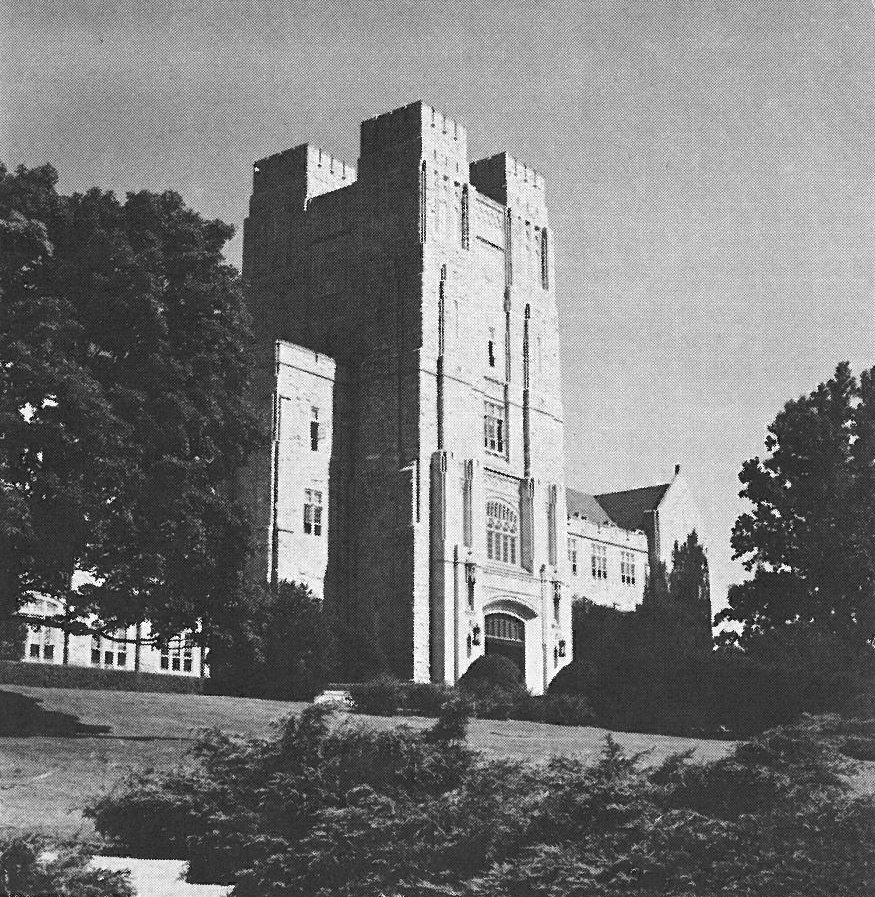
The Commission's comprehensive study of higher education in Virginia resulted in a long series of recommendations; some of them have been mentioned elsewhere in this report. They underscore the resurgence of Virginia's educational efforts at all levels.
One of the Commission's recommendations concerned the suitability of the university's name, Virginia Polytechnic Institute. The Commission report suggested that "the name Virginia Polytechnic Institute does not convey to the average citizen in the United States an accurate conception of the role and scope of the program maintained at Blacksburg." The Commission recommended that attention be given "to the choice of a better designation for the institution, one that will indicate its historic importance as the land-grant university of Virginia." The word "University," with a capital "U," should be incorporated in the name of the institution to better characterize its role in Virginia's higher education system, the Commission noted.
It is a point not to be belabored, but the Commission's specific recommendation was quite unexpected, and consequently quite complimentary to V.P.I. It ultimately will have to be given serious consideration, for the Commission's objections to the university's legal name do have some validity.
The V.P.I. self-study, now in its final phase, has been mentioned previously. The opportunity it provides for an intensive examination of all the university's diverse activities, and for a greater understanding of V.P.I.'s strengths and deficiencies, is extremely valuable. Undoubtedly many of the suggestions for improving and strengthening various phases of the university's operations will be reviewed and implemented in the months and years ahead. Faculty participation in the study has been excellent.
Coming as it does in a period of very rapid growth, the self-study is particularly useful. In less than a decade V.P.I.'s enrollment increase will be larger than the total student body currently enrolled in any Virginia institution. The resulting problems of organization and administration are not simply resolved. But as this report has suggested, the fact of rapid growth itself provides opportunity for dramatic improvements in the academic programs of the institution.
Such a situation is not unique, of course; many institutions in America have had to sustain an even more rapid growth, and a parallel improvement of their academic programs. But the events of the past year at Virginia Polytechnic Institute and in Virginia are more than encouraging. They have provided the foundation on which much more rapid progress can be constructed. Barring unforeseen catastrophe, the years ahead indeed will be years of achievement, both for the Commonwealth and for its land-grant university.



